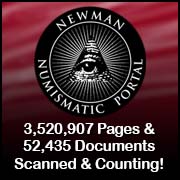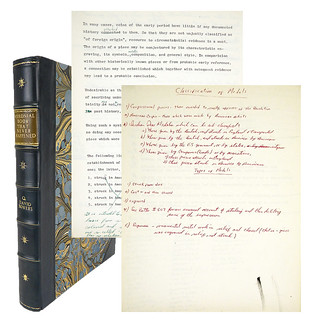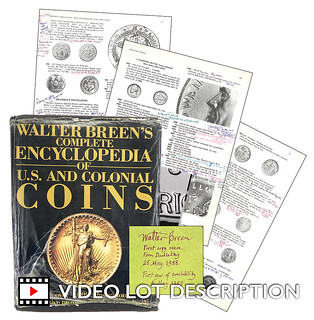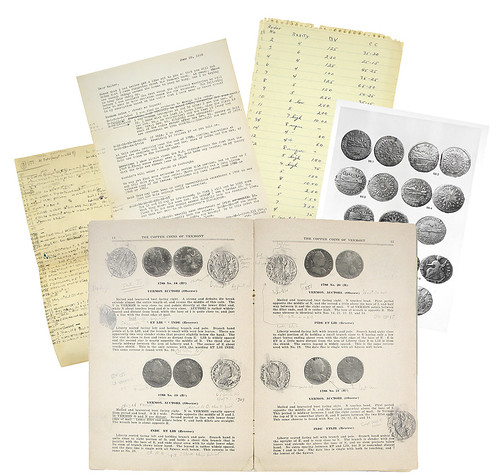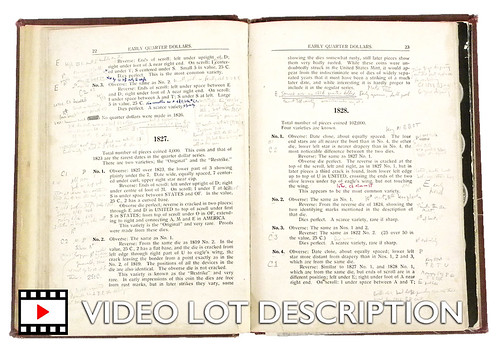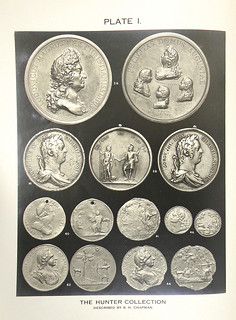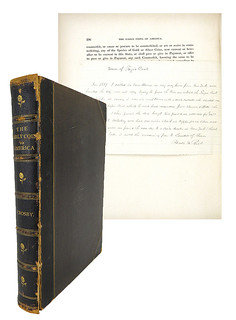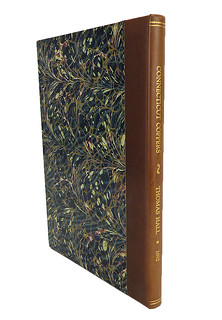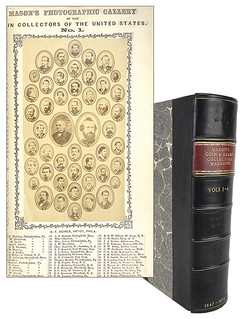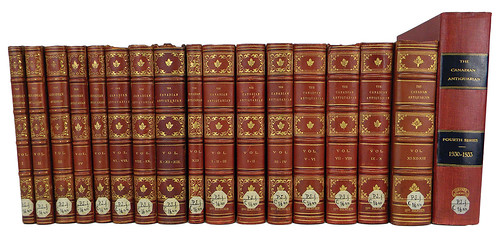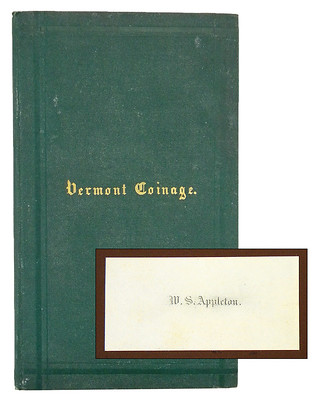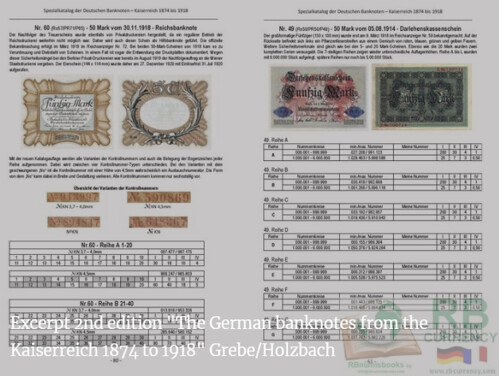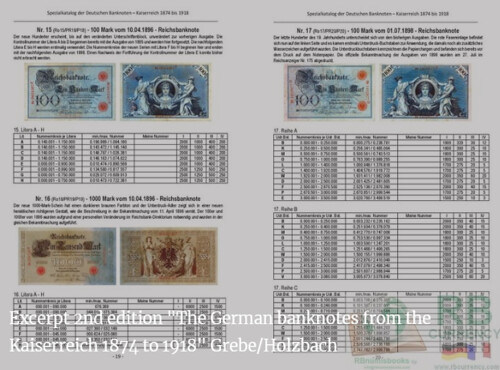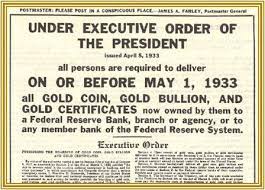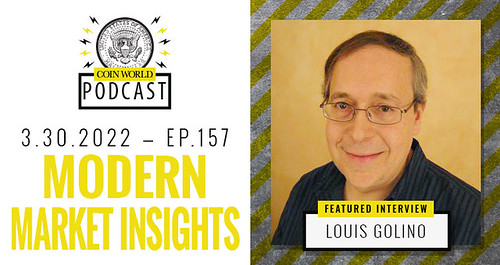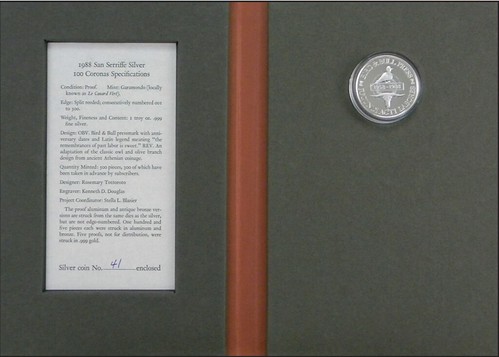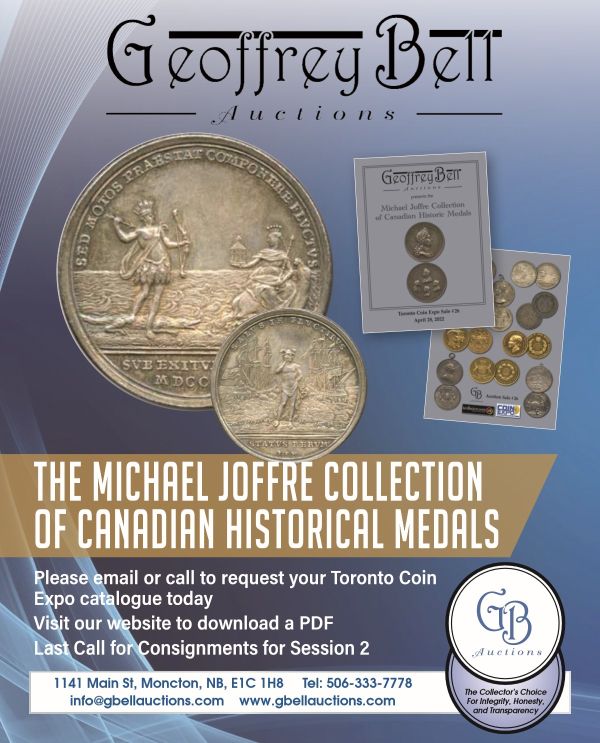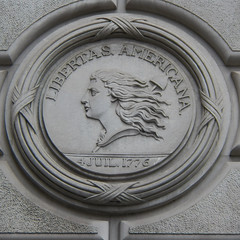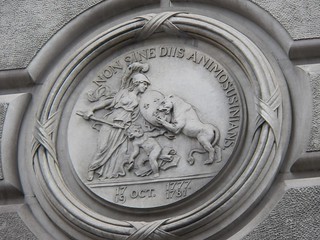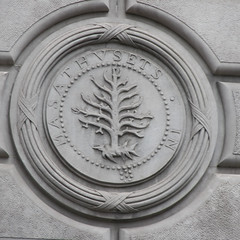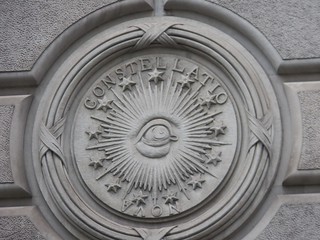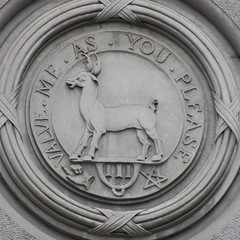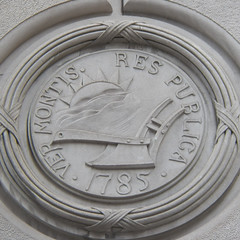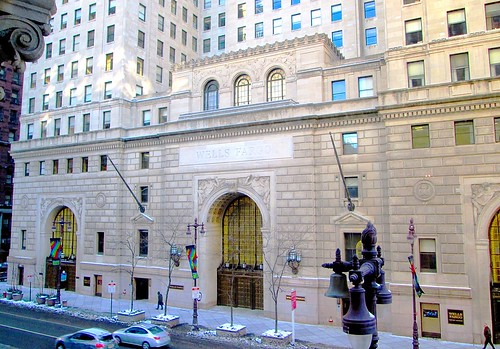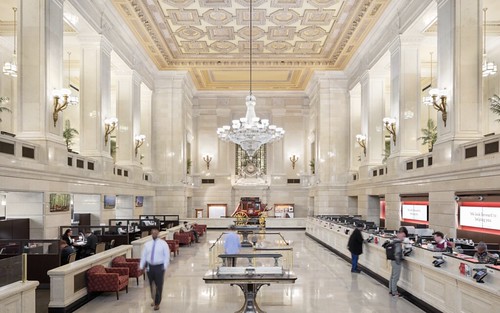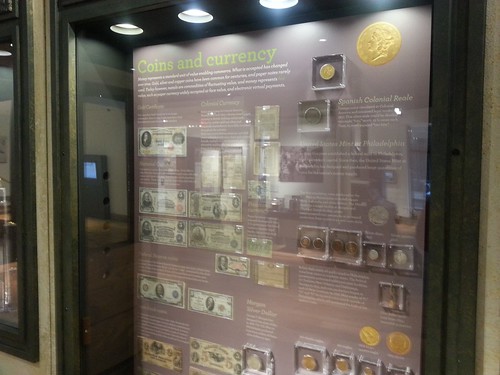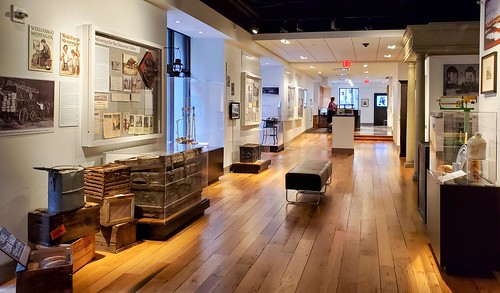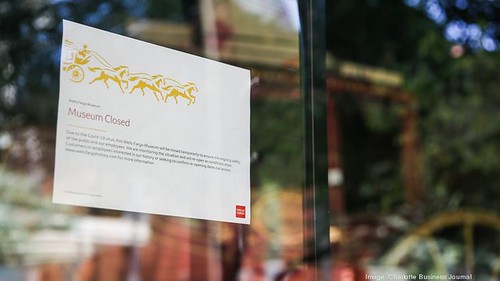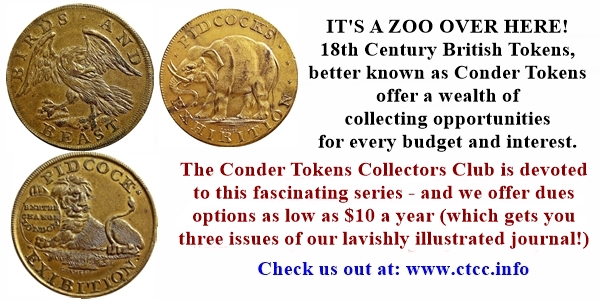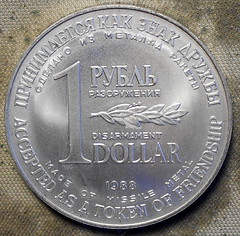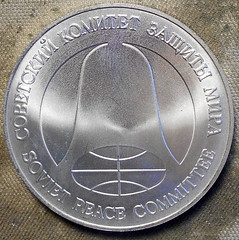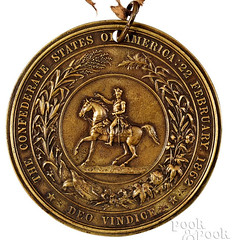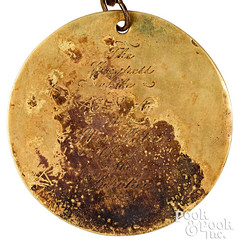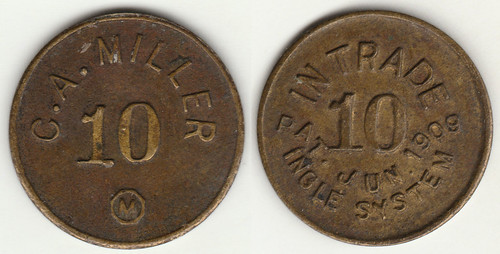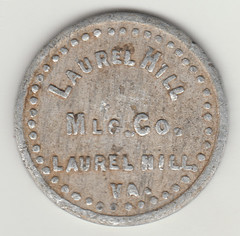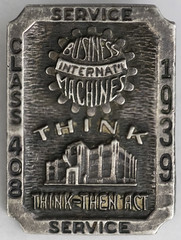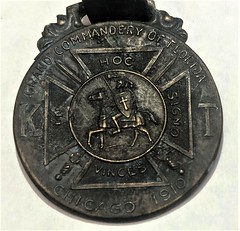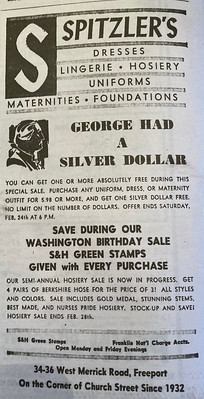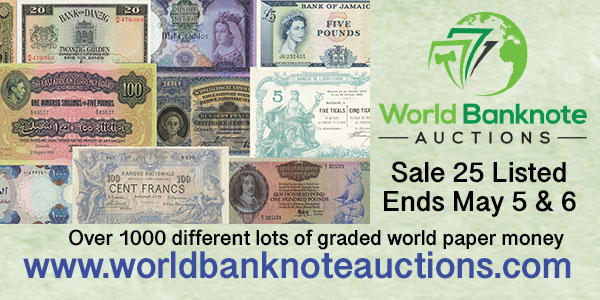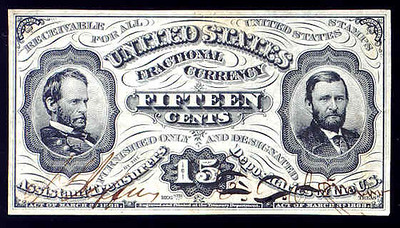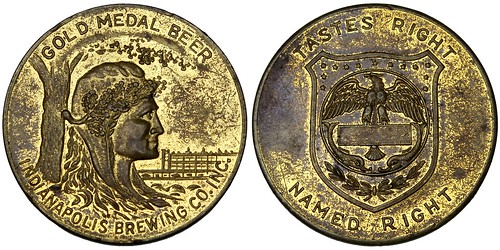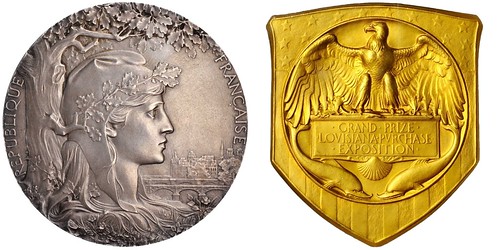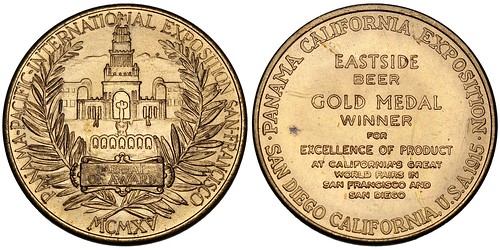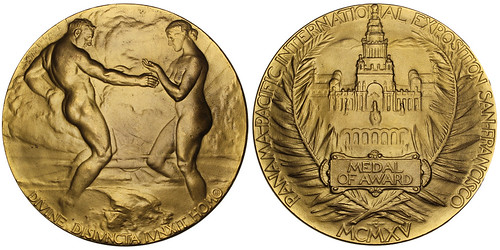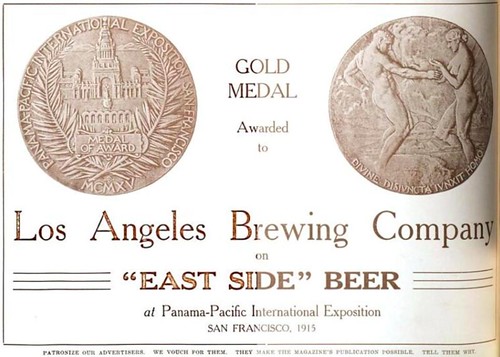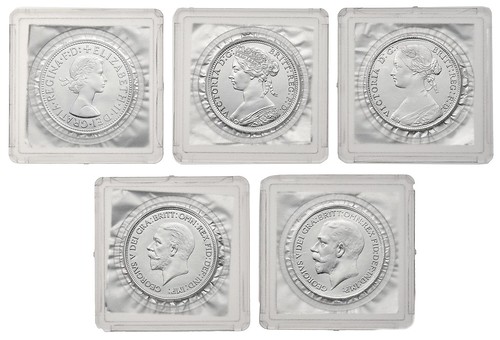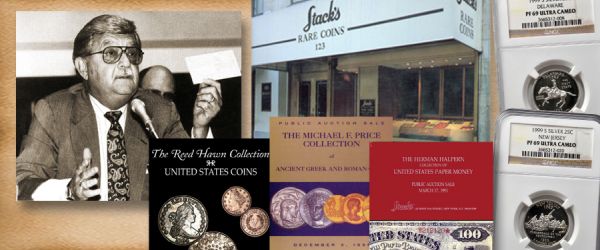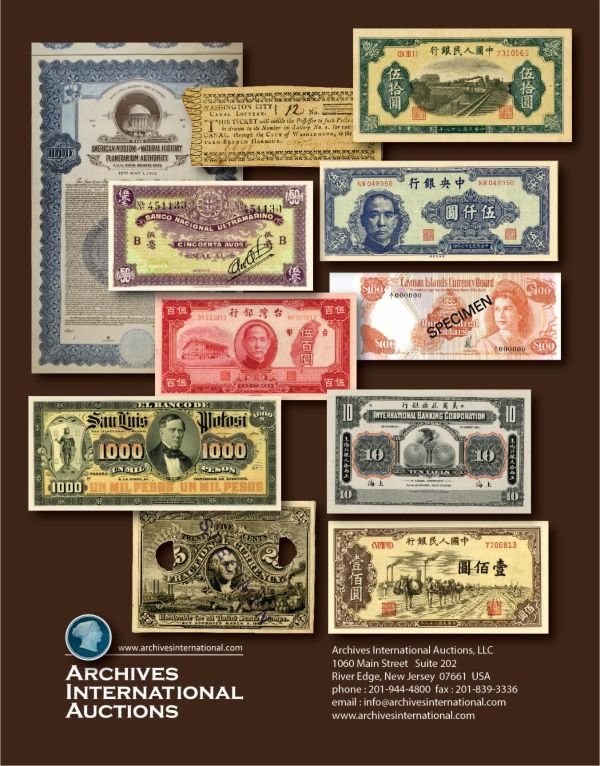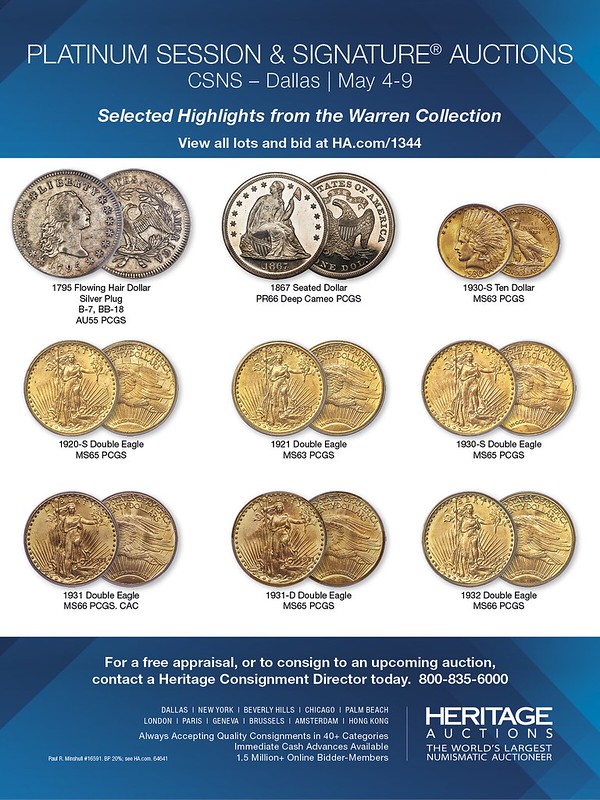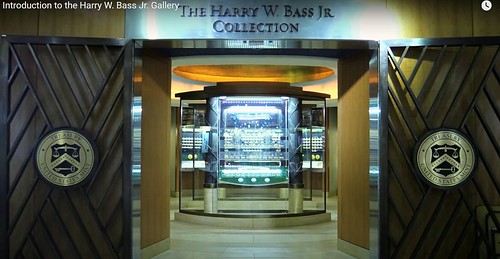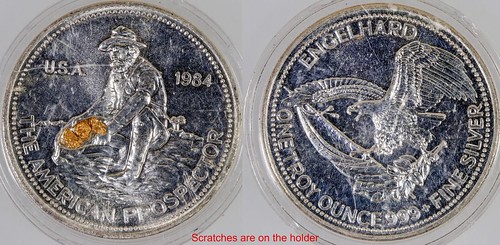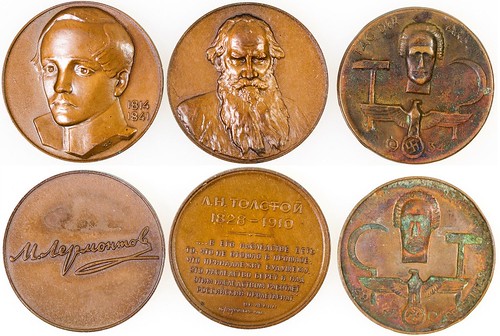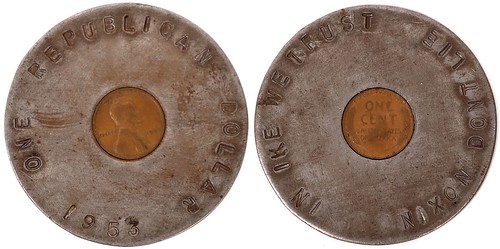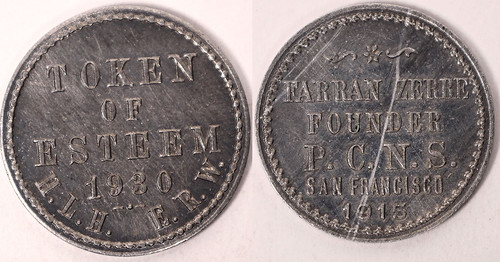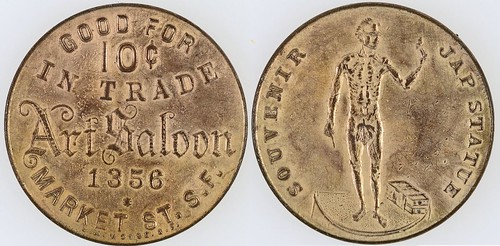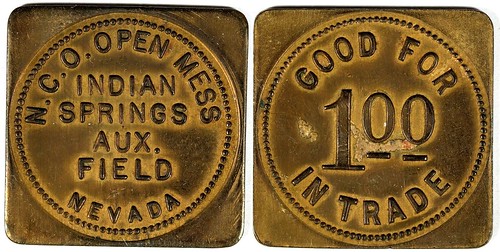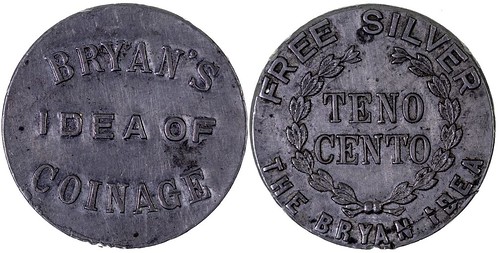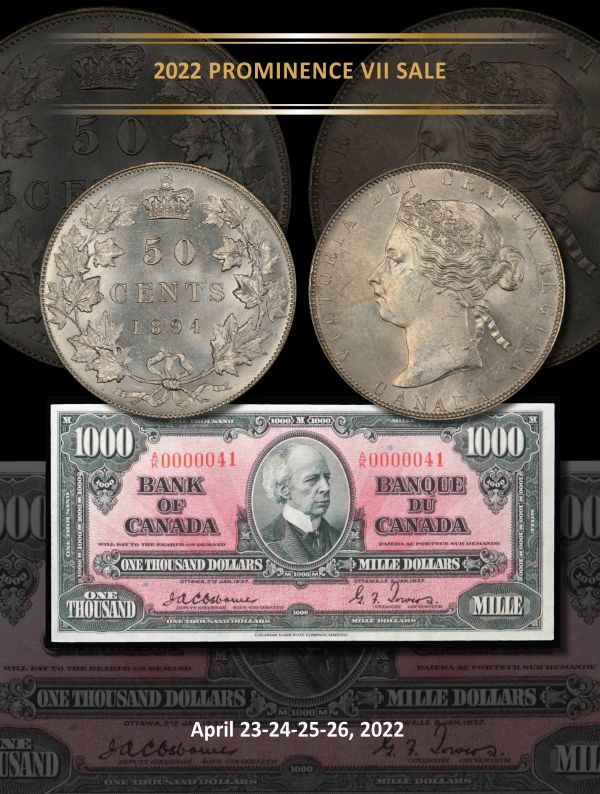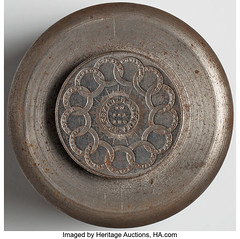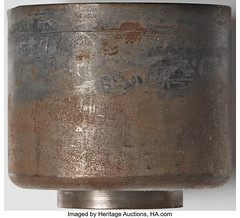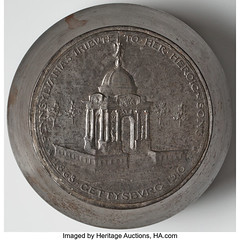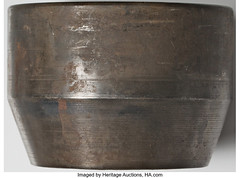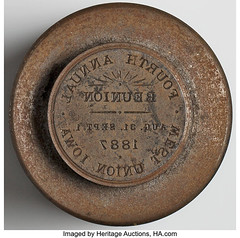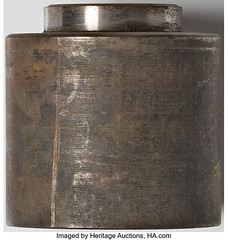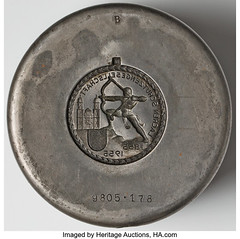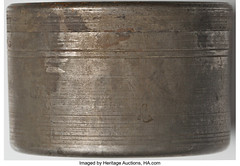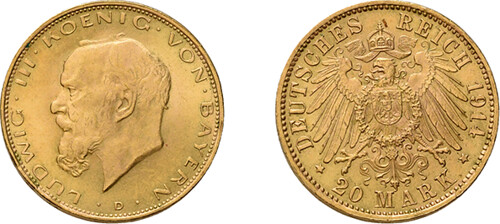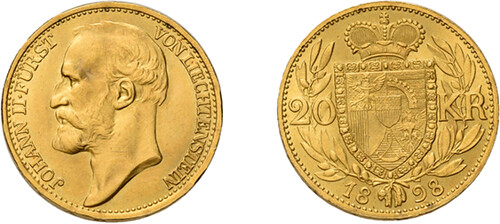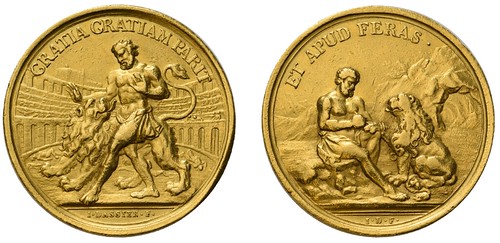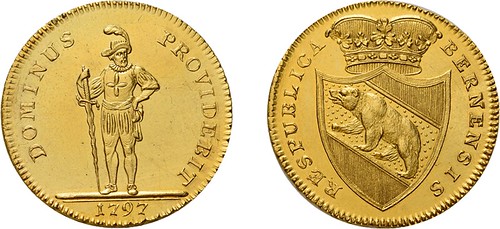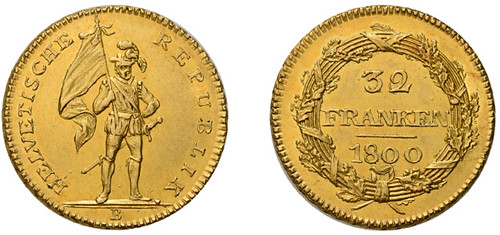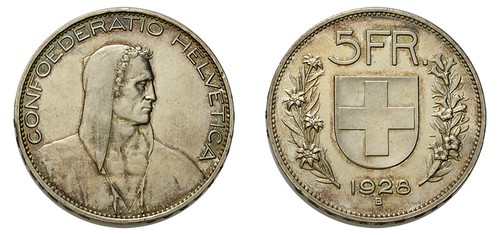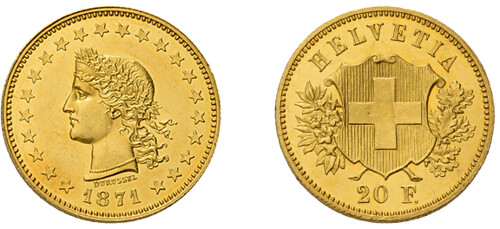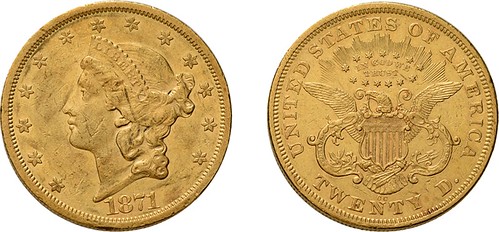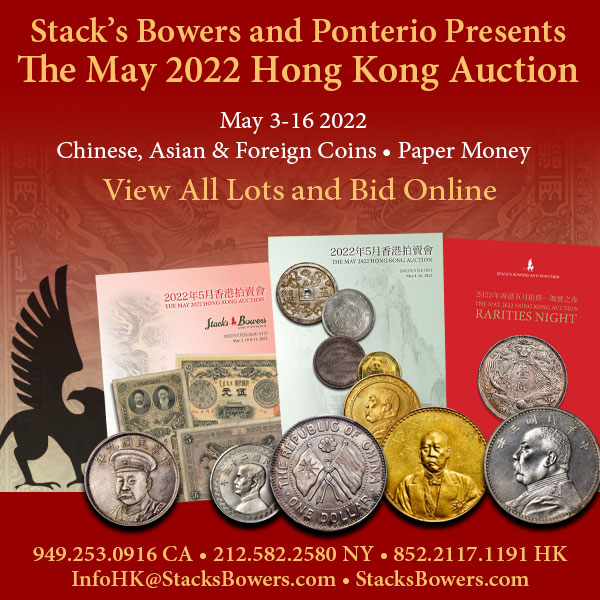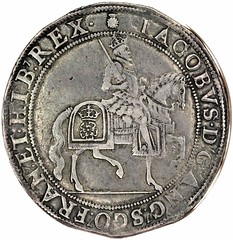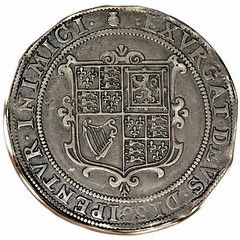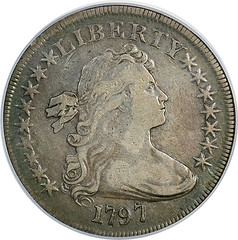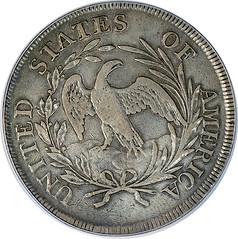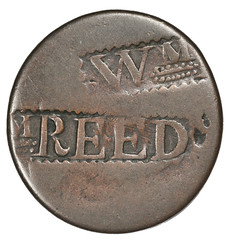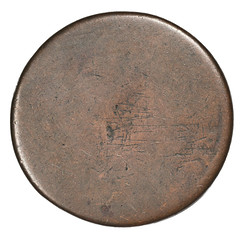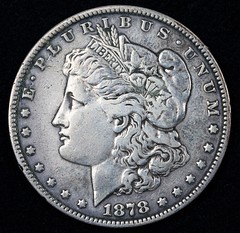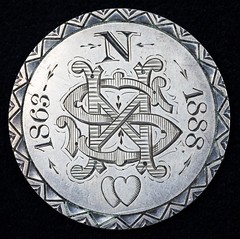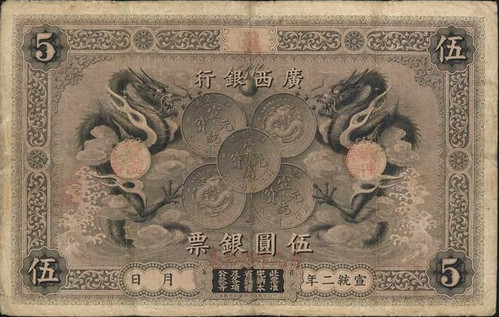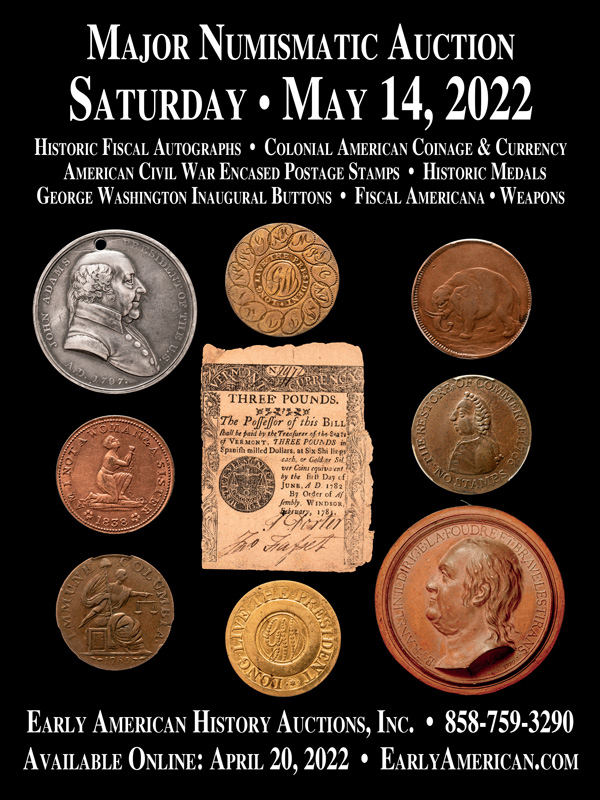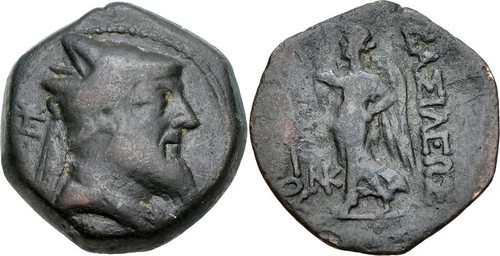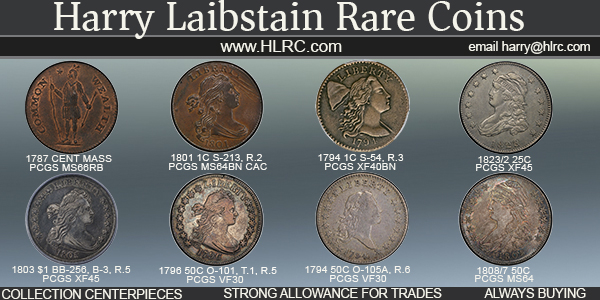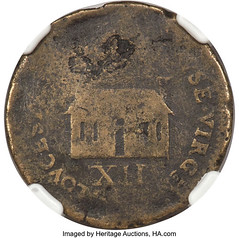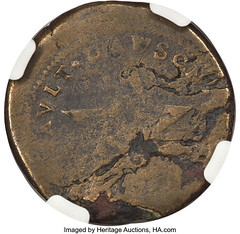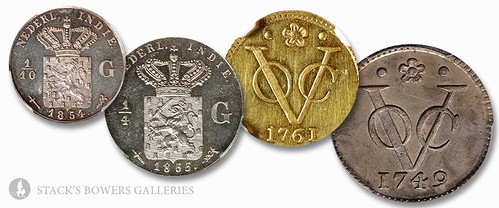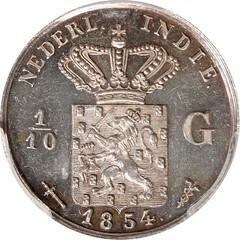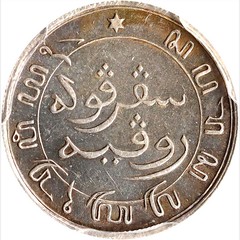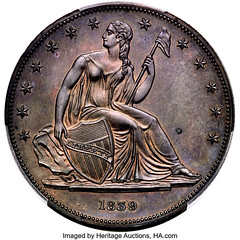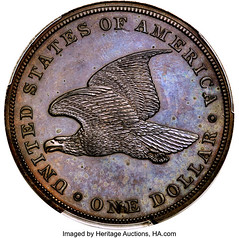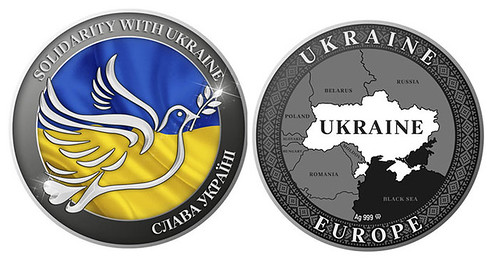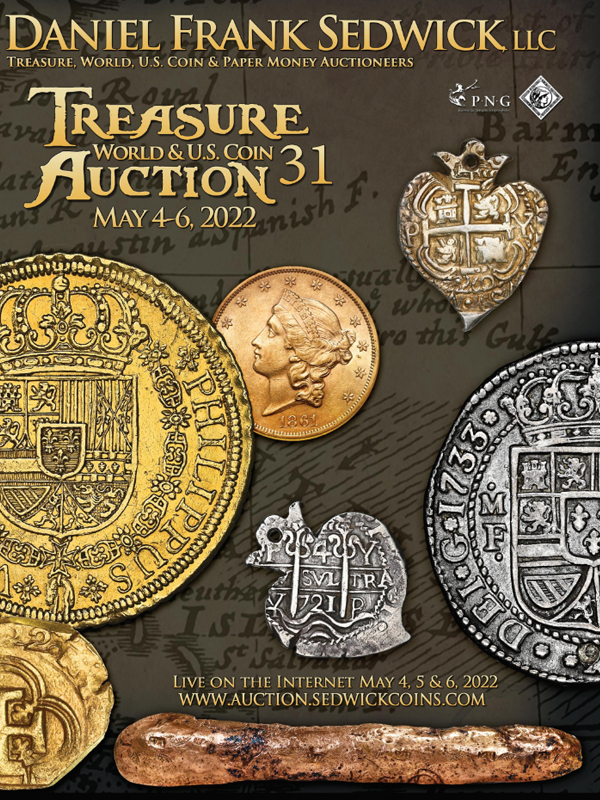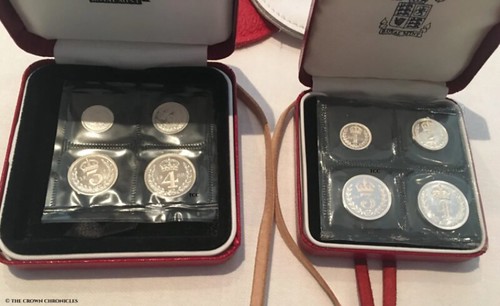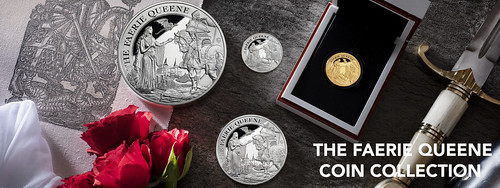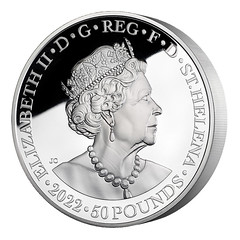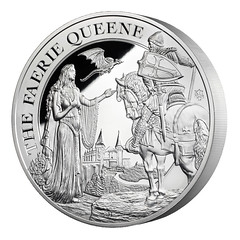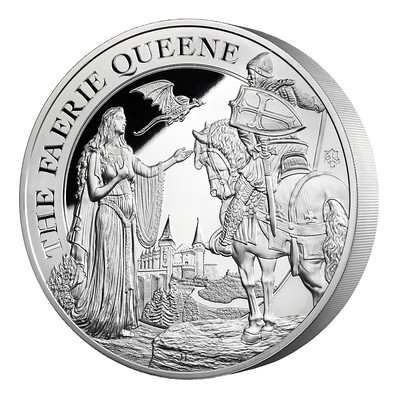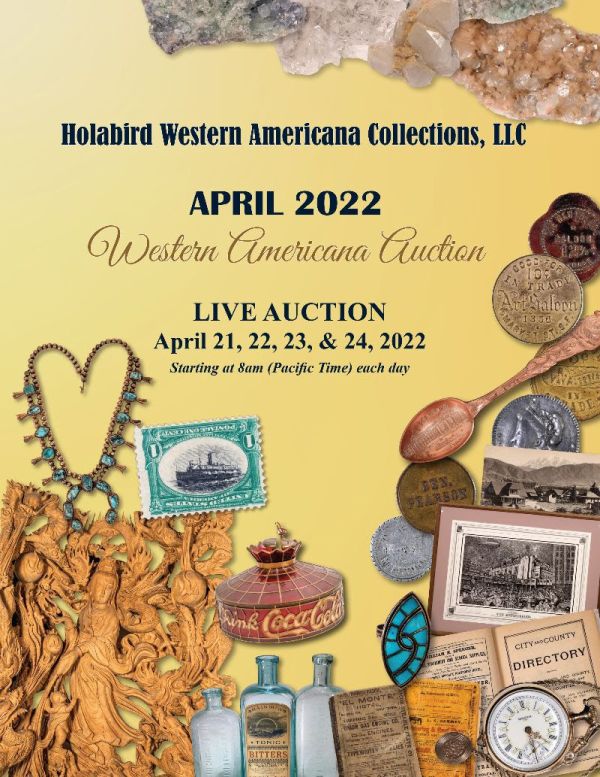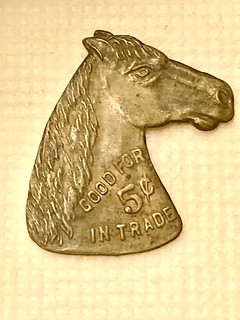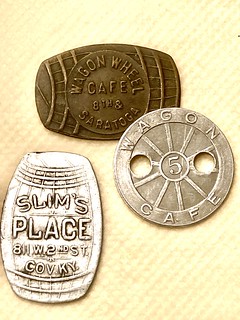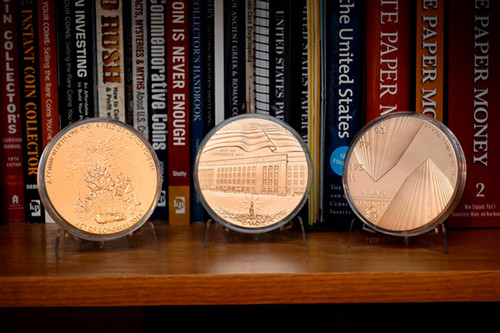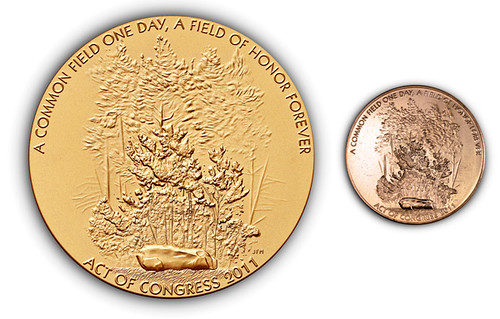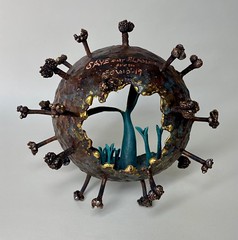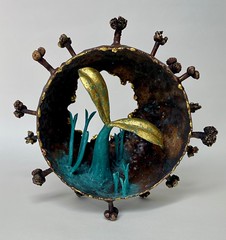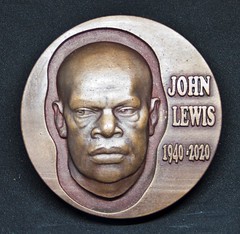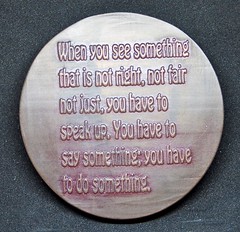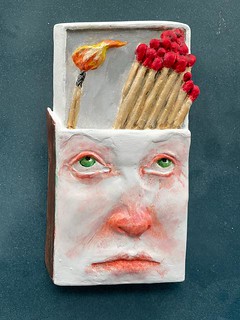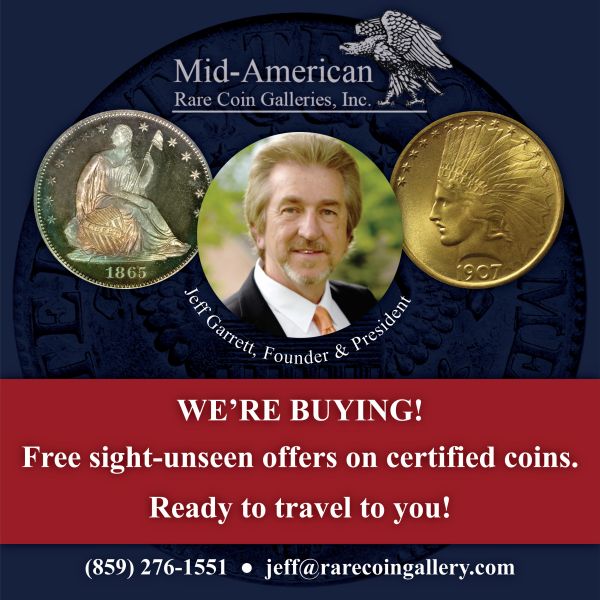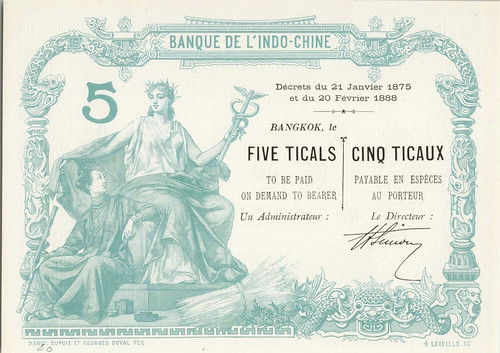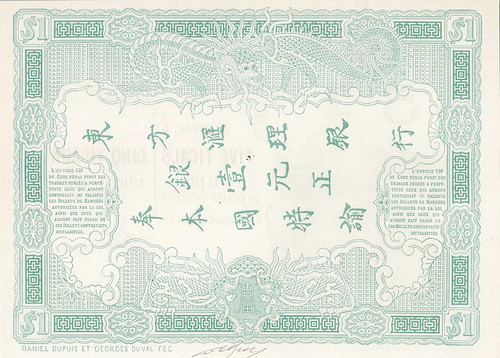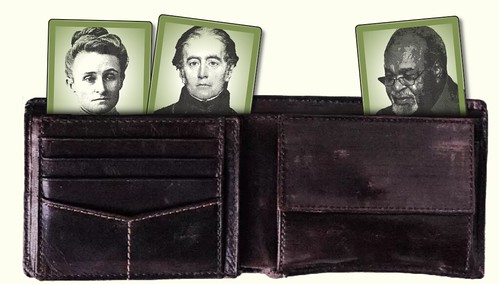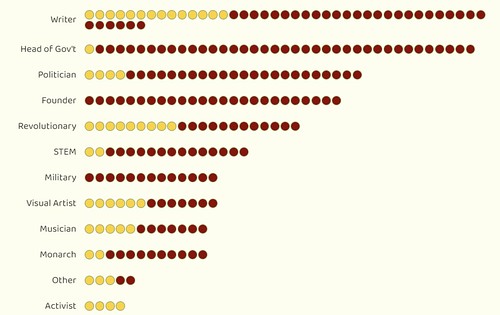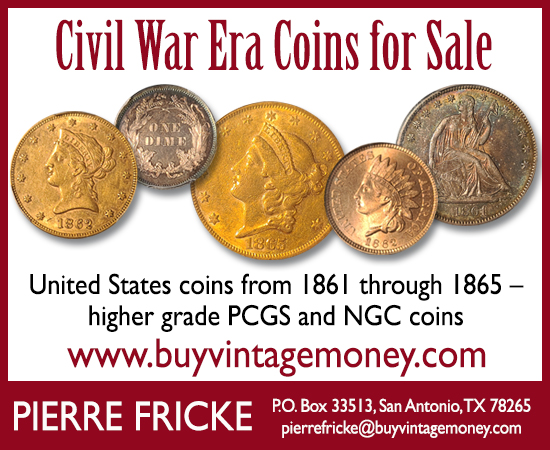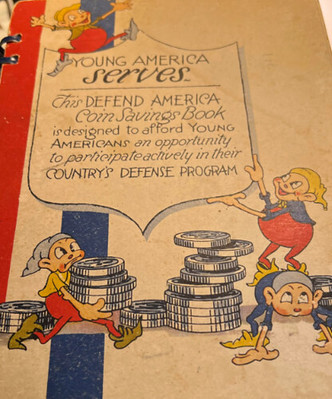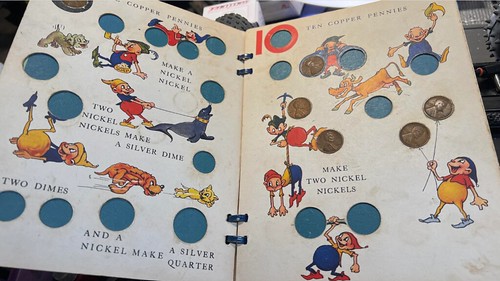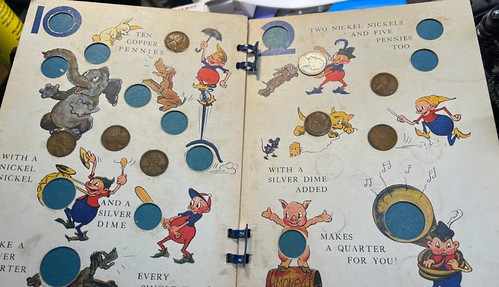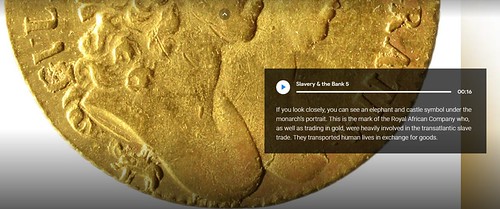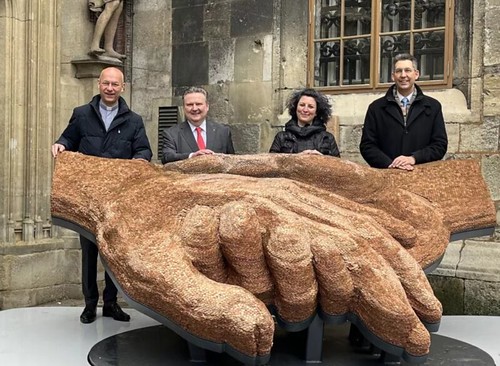
Visit our NBS Sponsors



About UsThe Numismatic Bibliomania Society is a non-profit association devoted to the study and enjoyment of numismatic literature. For more information please see our web site at coinbooks.org SubscriptionsThose wishing to become new E-Sylum subscribers (or wishing to Unsubscribe) can go to the following web page link MembershipThere is a membership application available on the web site Membership Application To join, print the application and return it with your check to the address printed on the application. Print/Digital membership is $40 to addresses in the U.S., and $60 elsewhere. A digital-only membership is available for $25. For those without web access, write to: Charles Heck, Treasurer AsylumFor Asylum mailing address changes and other membership questions, contact Chuck at this email address: treasurer@coinbooks.org SubmissionsTo submit items for publication in The E-Sylum, write to the Editor at this address: whomren@gmail.com BUY THE BOOK BEFORE THE COIN |
- WAYNE'S WORDS: THE E-SYLUM APRIL 17, 2022
- MORE SYD MARTIN LIBRARY SELECTIONS
- NEW BOOK: GERMAN BANKNOTES 1874-1918, 2ND ED.
- NNP ADDS TREASURY DEPARTMENT PRESS RELEASES
- AUDIO: SHANNA SCHMIDT, LOUIS GOLINO
- THE COINAGE OF SAN SERRIFFE
- PHILADELPHIA BANK BUILDING COIN SCULPTURES
- NOTES FROM E-SYLUM READERS: APRIL 17, 2022
- U. S. POSTAGE AND FRACTIONAL CURRENCY WEBSITE
- MEDALLIC ART AS ADVERTISING IN BREWING
- VOCABULARY TERM: IMPRESSION
- HARVEY STACK'S NUMISMATIC FAMILY, PART 119
- CSNS HONORS BETH DEISHER WITH BOWERS AWARD
- BASS COLLECTION DEPARTS ANA MUSEUM
- HOLABIRD APRIL 2022 SALE SELECTIONS
- THE FRED WEINBERG COIN DIE COLLECTION
- PETER RAPP MAY 2022 SALE
- NUMISMATIC NUGGETS: APRIL 17, 2022
- ANCIENT COINS OF THE KINGDOM OF SOPHENE
- 1714 GLOUCESTER SHILLING
- DUTCH EAST INDIES COINAGE
- COPPER 1839 GOBRECHT DOLLAR JUDD-107 RESTRIKE
- MODERN UKRAINIAN COINS AND MEDALS
- PRINCE CHARLES PERFORMS MAUNDY CEREMONY
- THE FAERIE QUEENE COINS BY JOEL ISKOWITZ
- THE WHIMSICAL TOKENS OF NORTHERN KENTUCKY
- LARGE BRONZE SEPTEMBER 11TH MEDALS
- 2022 AMERICAN MEDAL OF THE YEAR AWARDS
- SIAM 5 TICALS WITH FRENCH INDO-CHINA BACK
- WHO'S IN YOUR WALLET?
- THE DEFEND AMERICA COIN SAVINGS BOOK
- LOOSE CHANGE: APRIL 17, 2022
- SCULPTURE MADE FROM 1 MILLION EURO CENTS
Click here to read the thin version on the web
Click here to subscribe
Click here to access the complete archive
To comment or submit articles, reply to whomren@gmail.com
Content presented in The E-Sylum is not necessarily researched or independently fact-checked, and views expressed do not necessarily represent those of the Numismatic Bibliomania Society.
WAYNE'S WORDS: THE E-SYLUM APRIL 17, 2022
 New subscribers this week include:
Mike Costanzo and
Jason Smith.
Welcome aboard! We now have 6,982 subscribers.
New subscribers this week include:
Mike Costanzo and
Jason Smith.
Welcome aboard! We now have 6,982 subscribers.
C'mon - help us get to 7,000! Please send me the email addresses of friends you think may enjoy it as well and I'll send them a subscription. Contact me at whomren@gmail.com anytime regarding your subscription, or questions, comments or suggestions about our content.
This week we open with more Syd Martin library selections, one new book, an update from the Newman Numismatic Portal, notes from readers, and more.
Other topics this week include German banknotes, the Philadelphia Wells Fargo Museum, postage and fractional currency, the Harry Bass collection, auction previews, numismatic nuggets, the Gloucester shilling, Ukrainian coins and medals, the Faerie Queene coins, the American Medal of the Year, and the Defend America Coin Savings Book.
To learn more about the New Haven Restrike dies, Shanna Schmidt, Louis Golino, the coinage of San Serriffe, the Soviet Peace Committee medal, the New Haven Italian Circle token, foil impressions, the Republican Dollar, the Pacific Coast Numismatic Society token of esteem, the Bryan Dime, the James I horseman crown, King Xerxes, Dutch East Indies coinage, the John Lewis medal, and the sculpture made from 1 million Euro cents, read on. Have a great week, everyone!
Wayne Homren
Editor, The E-Sylum
THE BOOK BAZARRE
MORE SYD MARTIN LIBRARY SELECTIONS
Here are some more highlights from the Syd Martin library, being sold by Kolbe & Fanning April 30, 2022. -Editor
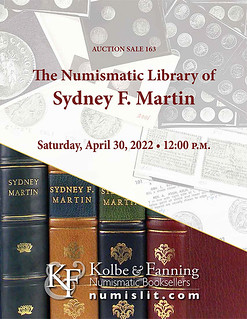 Kolbe & Fanning Numismatic Booksellers will be selling the outstanding library formed by Sydney F. Martin on April 30, 2022. The Martin Library is one of the finest formed on the subject of early American coinage, and includes many titles on related areas of European numismatics as well. The sale has been generating considerable interest and promises to be an exciting event.
Kolbe & Fanning Numismatic Booksellers will be selling the outstanding library formed by Sydney F. Martin on April 30, 2022. The Martin Library is one of the finest formed on the subject of early American coinage, and includes many titles on related areas of European numismatics as well. The sale has been generating considerable interest and promises to be an exciting event.
Some highlights of the sale include:
Lot 40: the original manuscript of an unpublished book by Q. David Bowers on colonial coins, written in the 1960s and 1970s
Lot 64: Breen's personal annotated copy of his Complete Encyclopedia, with thousands of handwritten annotations compiled for a revised edition that was never published
Lot 60: Walter Breen and Ken Bressett's working notes on Vermont coppers, including correspondence, photographs, handwritten and typewritten notes, and Breen's annotated copy of Richardson
Lot 77: a copy of Ard Browning's classic work on early U.S. quarter dollars, extensively annotated in great detail by Walter Breen, with various inserts
Lot 107: the rare plated edition of S.H. Chapman's 1920 sale of the W.H. Hunter collection, exceptionally important for American and Canadian medals
Lot 140: Horatio Rust's subscription copy of Sylvester S. Crosby's Early Coins of America, with his handwritten account of the discovery of the New Haven Restrike
dies
Lot 198: a fine first edition copy of Dr. Thomas Hall's rare study of the Connecticut coppers of 1787
Lot 251: J. Colvin Randall's complete set of Mason's Coin and Stamp Collectors' Magazine, with a superb Photographic Gallery plate
Lot 299: an exceptional, entirely complete set of the very rare Canadian Antiquarian and Numismatic Journal
Lot 353: Edmund Slafter's extremely rare monograph on The Vermont Coinage, from the library of William Sumner Appleton.
Register early to bid online
Bids may be placed via post, email, fax or phone, as well as online. Kolbe & Fanning use Auction Mobility as our third-party online bidding platform. Auction Mobility is an app-based platform allowing users the ability to participate in the sale through phones, tablets and computers. To register for the sale, bidders must go to
bid.numislit.com and sign up. Once you have set up an account, you may browse lots, place advance bids, or participate in the live sale online. Those wishing to participate on their devices can download the Kolbe & Fanning app through the Apple or Google Play Store. The sale is also listed on Biddr and NumisBids.
The printed catalogue of the Martin Library has been mailed to all active customers on our mailing list. As international mail speeds have been slow in recent months, we encourage our international clients to consult the electronic catalogue in case their printed catalogue does not arrive promptly. A PDF of the printed catalogue has been posted to our main website at numislit.com for those who prefer that format. Bids placed via post, email, fax or phone must be received by April 29, the day before the sale, in order for them to be processed. Advance absentee bids may also be placed at any time online at bid.numislit.com. Live internet bidding will be available during the sale itself through the same platform.
Kolbe & Fanning Numismatic Booksellers LLC is a licensed and bonded auction firm in the State of Ohio. For more information, please see the Kolbe & Fanning website at numislit.com or email David Fanning at df@numislit.com. To register for the sale, go to bid.numislit.com. We look forward to your participation.
To read the earlier E-Sylum articles, see:
KOLBE & FANNING SYD MARTIN LIBRARY SALE
(https://www.coinbooks.org/v25/esylum_v25n14a02.html)
KOLBE & FANNING SYD MARTIN LIBRARY SELECTIONS
(https://www.coinbooks.org/v25/esylum_v25n15a02.html)
NEW BOOK: GERMAN BANKNOTES 1874-1918, 2ND ED.
Here's a Google-translated article from the Geldscheine Online newsletter about a new book on German banknotes. -Editor
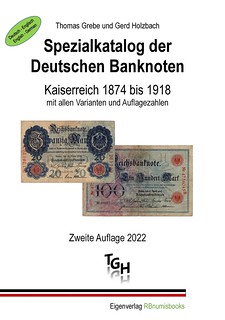 Thomas Grebe and Gerd Holzbach
Thomas Grebe and Gerd Holzbach
Special catalog of German banknotes from the Kaiserreich from 1874 to 1918 with all variants and edition numbers
124 pages, illustrated in color and black and white throughout,
Format 21 cm x 29.7 cm, paperback,
Goldbach 2022
Price: 24.90 euros
ISBN: 978-3-94995-800-7
The authors' special catalogue, bilingual in German and English, on Reichsbanknotes and Reichs- and Darlehnskassenscheine of the German Empire has already been published in its second edition.
The aim was to gain new insights into the editions and variants resulting from the allocation of serial and underprinted letters with the associated number ranges and their current rarity through an unprecedented viewing of banknotes in collections, in specialist shops and at auctions to win. The decisive factor here is what is referred to as a variant. Of course, standard catalogs can only be limited to the essential differences in the design of banknotes and cannot list and evaluate every combination of underprinted serial letters that occurs as a separate variant. That would also go beyond the scope and in the end is usually only addressed to special collectors, while the vast majority of collectors with one note per type, but mostly satisfied with one note per version. After all, there are still so many more notes with fascinating history and design to discover and collect. However, new insights can sometimes only be gained through a mass evaluation.
The authors did not shy away from hard work. For the first edition, more than 100,000 banknotes in large private collections, extensive duplicate stocks and auction goods were scrutinized and, based on the evidence of the lowest and highest control numbers, previously known number ranges could be expanded and clearer information on the editions of series could be given . This also triggered the urge to research among many collectors and numerous reports of control numbers followed, with which the number ranges could be further expanded.
With the second edition, the numbering in the catalog was adjusted, among other things because now - as in my catalog "The German banknotes from 1871" since the 21st edition 2018 - not only the hundreds and thousands with red and green seals and control numbers, but also the 1914 loan register slips with red and blue seals have their own main numbers. Strictly speaking, however, the notes with the green and blue seals do not belong in a catalog with the issues of the Empire because they were only issued during the "Weimar Republic", even if they still bear the old date. But of course you can do that, because the layman will always look at the face value and the date first to determine a note.
If the spirit of research has also been awakened and if you would like to help support the authors and thus contribute to further knowledge, you can order the recommended book from the company RBCurrency:
RBCurrency Germany Rossberg/Banspach GbR
Aschaffenburger Strasse 138
D-63773 Goldbach
Phone 06021/3288560
Email:
info@rbnumisbooks.com
If you would like to help to contribute to further research into paper money in the Kaiserreich with your own reports, please send your report with photo credits directly to: VARENTAN concerned@t-online.de.
To read the complete article, see:
Neue Auflage des Spezialkatalogs zu den Banknoten des Kaiserreichs
(https://www.geldscheine-online.com/post/neue-auflage-des-spezialkatalogs-zu-den-banknoten-des-kaiserreichs)
For more information, or to order, see:
https://rbcurrency.com/i/new-rbnumisbooks-info
NNP ADDS TREASURY DEPARTMENT PRESS RELEASES
The latest addition to the Newman Numismatic Portal is a collection of Treasury Department press releases. Project Coordinator Len Augsburger provided the following report. Thanks. -Editor
Gold Coin Circulation in 1917
Although not withdrawn until 1933, the Treasury Department discouraged use of gold coin as early as 1917. A December 2, 1917 press release recently added to Newman Portal outlined the talking points. Secretary W. G. McAdoo noted that circulation of gold coin caused rapid
abrasion and loss of value, and that most people preferred to use paper money (in this case gold certificates) anyway. McAdoo felt that gold should be reserved for backing the certificates, or foreign exchange settlements, and only then when necessary. The Secretary castigated the use of machines for counting gold coins and considered it selfish and unpatriotic
to demand gold coins in commerce. One can only observe that the eventual removal of gold coin from circulation, in 1933, was politically facilitated by first changing it into paper.
Thanks to Roger Burdette for pointing out the collection of Treasury Department press releases available at FRASER, the online Federal Reserve Library.
Image: Executive Order 6102, demanding surrender of gold coin, bullion, and certificates.
Link to Statement by Secretary McAdoo on Use of Gold Coin as Circulating Medium:
https://nnp.wustl.edu/library/publisherdetail/543206
Link to Treasury Department press releases on FRASER:
https://fraser.stlouisfed.org/title/6111
Roger adds:
"This also led to Treasury encouraging Western state citizens to turn in badly worn gold coins in exchange for Federal Reserve Notes. Normally, the worn coins would have been accepted only at bullion weight, which was often several dollars below face value. It cost Treasury over $100k to buy the worn coins."
Here's an excerpt from Roger's 2018 book Saint-Gaudens Double Eagles (p268-269). -Editor
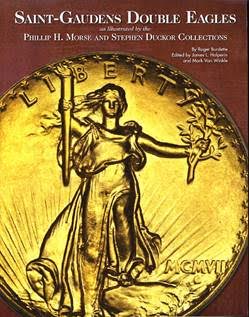 "During the war, Treasury prohibited gold exports, discouraged gold coin circulation and encouraged banks to remove good gold coins from circulation and return them to the Federal Reserve Banks. As banks followed treasury instructions, the quantity of gold coin gradually diminished along the Pacific coast. The mint and assay offices would only accept worn gold at its weight, not face value. Thus, someplace along the chain of commercial ownership, someone got less than nominal value for their coins.
"During the war, Treasury prohibited gold exports, discouraged gold coin circulation and encouraged banks to remove good gold coins from circulation and return them to the Federal Reserve Banks. As banks followed treasury instructions, the quantity of gold coin gradually diminished along the Pacific coast. The mint and assay offices would only accept worn gold at its weight, not face value. Thus, someplace along the chain of commercial ownership, someone got less than nominal value for their coins.
"Before the war, U.S. mints had engaged in gratuitous re-coinage. Lightweight coins were separated from standard pieces, and melted, then struck into new coins of full weight. The Mint Bureau reported the difference between actual gold content and face value as a loss, and it was treated as a necessary obligation required to maintain integrity of the coinage. As noted above, exchange rates between San Francisco and New York tended to pull new gold coins out of circulation for shipment east, leaving only the worn coins for local use.
"With Pacific coast gold coins not being replaced, their actual metallic value declined due to abrasion. The treasury decided in February 1917 to redeem any gold coins presented by banks and individuals at face value for the limited period of ninety days. (Unofficially, the redemption period was nearly a year.) The government would absorb the loss and pay for the redemption in Federal Reserve Notes. Opponents felt the cost would be too high, while proponents argued it gave owners of worn coin fair value, and also helped the country by adding gold to the national reserves.
"Assistant United States Treasurer in San Francisco, William J. McGee, was quoted as stating the plan would cost about $100,000. [source of $100k estimate -- [no title],
New York Times, February 12, 1917. p.14.]
AUDIO: SHANNA SCHMIDT, LOUIS GOLINO
Here are two podcast episodes I thought I'd mention this week. The first is an episode of The Planchet from the American Numismatic Society featuring an interview with NBS Board Member Shanna Schmidt. -Editor
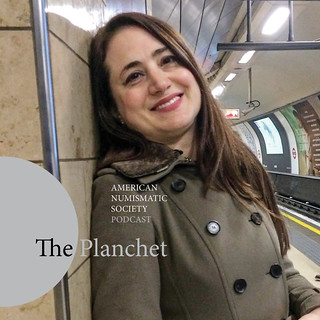 Season 3 of The Planchet podcast begins with a wide-ranging interview with Shanna Schmidt of Shanna Schmidt Numismatics. Since 2019, Shanna has been a Fellow of the American Numismatic Society and has also served as a board governor for the American Numismatic Association (ANA). She also held a board position with the International Association of Professional Numismatists (IAPN) and was a full member of the Professional Numismatists Guild (PNG). In this episode, we talk about growing up in a numismatics household, how she became a coin dealer after a career in advertising, advice to those starting a new business and to collectors new to the hobby, her work with auction representation, and her love of Chopin.
Season 3 of The Planchet podcast begins with a wide-ranging interview with Shanna Schmidt of Shanna Schmidt Numismatics. Since 2019, Shanna has been a Fellow of the American Numismatic Society and has also served as a board governor for the American Numismatic Association (ANA). She also held a board position with the International Association of Professional Numismatists (IAPN) and was a full member of the Professional Numismatists Guild (PNG). In this episode, we talk about growing up in a numismatics household, how she became a coin dealer after a career in advertising, advice to those starting a new business and to collectors new to the hobby, her work with auction representation, and her love of Chopin.
To listen, see:
S3, Ep. 1. A Conversation with Shanna Schmidt
(https://numismatics.org/pocketchange/03-01/)
The Coin World podcast episode #157 with Jeff Starck and Larry Jewett features an interview with numismatic writer Louis Golino beginning at the 32 minute mark. -Editor
Larry and Jeff discuss Congressional Gold Medals and the bronze duplicates, before speaking with and learning from modern market observer Louis Golino.
To listen, see:
EP157: Modern market insights – an interview with Louis Golino
(https://www.coinworld.com/news/us-coins/cwpod_ep157)
THE COINAGE OF SAN SERRIFFE
Earlier I'd asked, "Who can tell us numismatic connections to the republic of San Serriffe?" The definitive article on "The Coinage of San Serriffe" by Pete Smith appeared in the Spring 2019 issue of our print journal The Asylum. Here's an excerpt. -Editor
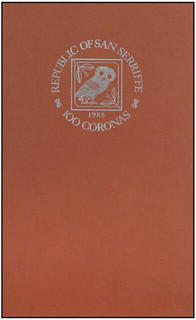 This has the best of everything we look for in numismatic literature. It is the definitive work on the topic; a limited edition with fine printing and binding; a low mintage coinage; and a fascinating story. It has a long title, The First Fine Silver Coinage of the Republic of San Serriffe:
This has the best of everything we look for in numismatic literature. It is the definitive work on the topic; a limited edition with fine printing and binding; a low mintage coinage; and a fascinating story. It has a long title, The First Fine Silver Coinage of the Republic of San Serriffe: The Bird and Bull Press Commemorative 100 Coronas Including an Account of this Legendary Republic and its Connection with the Bull and Bird Press. With a description of similar rarities and special mention of Martin Coles Harmon, King of Lundy Island. By Henry Morris.
It was published in 1988.
The work includes two parts in a slipcase. The first item has text printed on French mouldmade Arches paper by the Bird and Bull Press. The second item is a folder with examples of the coinage.
Much of the work is devoted to discussion of
Unofficial Coins of the World
as described by Richard Kenney in The Numismatist from 1962 to 1964. Apparently the favorite of Morris was coinage produced for Lundy Island by Martin Coles Harmon.
The first edition was limited to 350 copies. This includes one silver commemorative coin in the folder. Also included was a bibliography of Bird and Bull Press publications over the past thirty years and has a certificate for 1000 shares of Bird and Bull stock.
What is described as the numismatic edition included examples of the silver, alu.minum and bronze coinage with a print run of 125. My recent acquisition has this three coins set.
Coins in the folder were issued to commemorate the thirtieth anniversary of Bird and Bull Press. On the obverse is the Bird and Bull pressmark with Latin legend that translates as. the remembrances of past labor is sweet.
On the reverse is a classic Athenian owl and legend Republic of San Serriffe / 100 Coronas.
The accompanying folder identifies the designer as Rosemary Tottoroto, engraver as Kenneth D. Douglas, and project coordinator as Stella L. Blazier.
The edge numbered, one ounce silver proof piece was issued in an edition of 500. Only 105 pieces were produced in aluminum and antique bronze. An additional five presentation pieces were struck in .999 gold.
The booklet I received also has two pieces of currency in the denomination of 25 Coronas, Series of 1986. These were hand printed in black and blue with serial numbers in red.
To read the earlier E-Sylum article, see:
MORE ON THE 1992 M. N. DAYCIUS PRANK
(https://www.coinbooks.org/v25/esylum_v25n14a07.html)
PHILADELPHIA BANK BUILDING COIN SCULPTURES
Regarding last week's image of a Fugio Cent on a Philadelphia bank building, Craig McDonald writes:
"The image of the Fugio obverse on the bank building in Philadelphia brought back some memories.
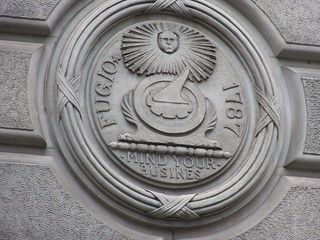 "I worked for the company that managed the computer systems for (at the time) Fidelity Bank, located in that building. The datacenter was on the fourth floor.
I traveled to that building once a week for several years, and ashamedly have to admit that I never looked up to see the artwork.
"I worked for the company that managed the computer systems for (at the time) Fidelity Bank, located in that building. The datacenter was on the fourth floor.
I traveled to that building once a week for several years, and ashamedly have to admit that I never looked up to see the artwork.
"At the 2017 Early American Coppers Convention held just down the street from the bank building, several of us went to lunch and walked by the building. Someone pointed out the artwork. I snapped a few pictures from street level."
Craig provided several photos. These are great! Thanks. -Editor
Dr. Google helped me find some more information on the building itself. -Editor
The Wells Fargo Building, originally the Fidelity-Philadelphia Trust Company Building, is a skyscraper in Center City, Philadelphia, Pennsylvania, United States. Designed in the Beaux-Arts style by the architectural firm Simon & Simon, the building was erected for the Fidelity-Philadelphia Trust Co. in 1928. The 29-story high-rise is listed on the National Register of Historic Places.
At street level, three arched entranceways line Broad Street. The central arch is slightly larger than the others to indicate the entrance to the main banking hall. Carved into the facade above the center arch is the building's name. Inside the arches and above the doorways are windows designed by d'Ascenzo Studios. Leaded panes of glass of various shades of amber are surrounded by a Renaissance-style border. Below the windows are bronze doors, each with 24 high-relief panels depicting the history of commerce and civilization. Bas-relief figures decorate each of the arches' spandrels. A male figure with a hammer representing industry and a female figure with a beehive representing thrift decorate the center arch. The arch closest to Sansom Street is decorated by two figures with cornucopias to represent abundance. The arch nearer to Walnut Street is decorated by a painter and a sculptor to represent art.
Next to the two smaller archways are carved medallions, one flanking each spandrel. The medallions closest to Sansom Street represent early American coins, a Pine Tree coin from Massachusetts and Grandi Copper coin from Connecticut. The medallions closest to the Walnut Street side represent the first American coin issued by Congress and the Eye Coin from Vermont. Two medallions on the Walnut Street side depict both sides of the Lafayette Medal. Only one medallion decorates the Samson Street side, depicting another early coin from Vermont.
The lobby holds a branch of the Wells Fargo History Museum; its exhibits include a stagecoach, telegraph equipment, historic clothing and currency.
Newspaper reporters aren't the best with numismatic facts. It's the Granby copper and the Libertas Americana medal for starters. But we should be glad the roundels got mentioned at all. -Editor
To read the complete article, see:
Wells Fargo Building (Philadelphia)
(https://en.wikipedia.org/wiki/Wells_Fargo_Building_(Philadelphia))
The interior includes a 2 1/2-story banking hall with cream-colored terrazzo marble and a five-tier, 1.25-ton chandelier, that measures 11 feet high by 11 feet wide. One of the largest made in the U.S., it contains 10,000 hand-cut and polished, Austrian and West German crystals. The bank branch also includes a 25 foot tall stained-glass window, with images of Independence Hall, George Washington's Farewell Address to Congress, William Penn's treaty with the Indians, the signing of the Declaration of Independence, Benjamin Franklin's printing office and Betsy Ross displaying the United States flag.
To read the complete article, see:
One of Philadelphia's most prestigious buildings, 123 South Broad Street is a Philadelphia landmark.
(https://www.123southbroad.com/building/)
Upon acquiring the historic home of the Fidelity-Philadelphia Trust Company, Wells Fargo set up the Wells Fargo History Museum in the lobby of the building. The Museum connects the history of Wells Fargo and the gold rush with the Philadelphia Mint and influential Philadelphia banks of the era.
In the Wells Fargo History Museum, you can learn about the important history of the financial institutions of Philadelphia and how they relate to the history of Wells Fargo. Inside the Museum are a number of exhibits and artifacts including an authentic Concord city-style stagecoach.
To read the complete article, see:
Wells Fargo History Museum
(https://www.theconstitutional.com/blog/2014/03/26/wells-fargo-history-museum)
Behind the facade at Broad and Walnut is a miniature museum filled with artifacts from 19th century American banking and commerce.
Set just off the lobby of the historic skyscraper, which played a starring role in the 1983 Dan Aykroyd-Eddie Murphy comedy Trading Places,
the museum is open to the public five days a week. Not many people know that, however, and attendance is exceedingly slim, according to staff.
No one ever comes in here,
said a woman custodian stationed near the entrance on a recent February afternoon. Never.
Well that's sad. I was at an ANA convention in downtown Philadelphia pre-pandemic, and I didn't know the Wells Fargo museum existed. Was there a convention tour? EAC missed it, too, but at least some attendees saw the outside. Have any of our readers visited? -Editor
To read the complete article, see:
Inside the money museum hidden a block from Philly City Hall
(https://billypenn.com/2020/02/17/inside-the-money-museum-hidden-a-block-from-philly-city-hall/)
As Joni Mitchell wrote in "Big Yellow Taxi", "You don't know what you've got 'til it's gone". The museum didn't survive the pandemic. Sad squared. -Editor
To read the complete article, see:
Wells Fargo to permanently shutter almost all of its museums, including Philadelphia location
(https://www.bizjournals.com/philadelphia/news/2020/09/02/wells-fargo-museum-closing-philadelphia.html)
To read the earlier E-Sylum article, see:
Fugio Cent on Philadelphia Bank Building
(https://www.coinbooks.org/v25/esylum_v25n15a18.html)
NOTES FROM E-SYLUM READERS: APRIL 17, 2022
Soviet Peace Committee Missile Relic Medal
Dick Grinolds writes:
"This tragically ironic Russian medal came in this week - I thought it might be of interest in the current international climate. It doesn't seem that long ago when my flight home had to circle for 45 minutes while Mikhail Gorbachev landed ahead of us on a good will trip to Minneapolis. Things change.
"Highly polished aluminum, 40mm, one of the most unusual relic or "made from" items I've handled."
O. Soviet Peace Committee (Same In Cyrillic, Bell). // R. 1 Disarmament Dollar Accepted As A Token Of Friendship, 1988, Made Of Missile Metal (Same In Cyrillic)
Times (and leaders) do change. Great item. Thanks. -Editor
CSA Medal Withdrawn
Last week I published a questionable "Congress of the C. S. A." medal, wondering if it were genuine. I thought I'd hear from multiple readers. Only one of you responded, but I wasn't surprised it was Alan Weinberg. -Editor
Alan writes:
"That CSA Stand Waite
Indian Peace medal is a total fantasy. Never awarded by the CSA and never used as an Indian Peace Medal. The well known Wyon London produced Confederate
shell
emblems under glass in a special presentation case, known to exist by the 100's today (or a cast of it), was used to produce this modern-made cockamamie
fantasy."
The last time I heard the word "cockamamie" was a report of John J. Ford, Jr. trying to dissuade another bidder for a lot he was interested in, bellowing "Whaddya want this put-together cockamamie thing for?" The report came from Alan. Anyway, Alan reported his opinion of this piece to the auction house, providing names of four prominent dealers he thought would confirm his observation. The head of the auction house called Alan back to report they would be withdrawing the lot. The lot description page has been taken down. Will the item go back to the consignor, only to reappear on the market another day? Time will tell. Let's keep our eyes open. -Editor
To read the earlier E-Sylum articles, see:
JOHN FORD BIDDING AT AUCTION
(https://www.coinbooks.org/esylum_v09n15a17.html)
NUMISMATIC NUGGETS: APRIL 10, 2022 : Stand Waite Congress of the CSA Medal
(https://www.coinbooks.org/v25/esylum_v25n15a24.html)
Buying Silver Coins from American GIs
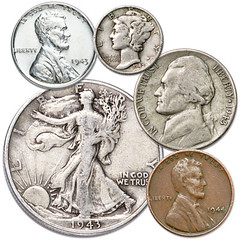 Nick Graver writes:
Nick Graver writes:
"The late Albert Levin of Chicago served in the US Army Medical Corps during World War II. The first Europeans they met as they stepped off the troopship were silversmiths and jewelers, clamoring to buy any US silver coins they had in their pockets. They had no sources of silver and they would buy coins or trade hand-crafted silver items like match boxes or cigarette cases for large numbers of our coins. That was a story I never encountered in my numismatic travels."
Me neither! Our ranks of WWII vets are thinning. Does anyone recall seeing or hearing about this? Thanks. -Editor
New Indian Peace Medals Book Links
Co-author Steve Nash reports that the web pages for his new book with Larry Lee have been fixed. Thanks. See the earlier article or follow the direct links below. -Editor
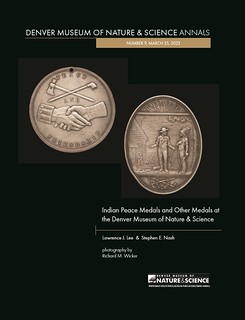 To purchase a printed copy, see:
To purchase a printed copy, see:
DMNS Annals 9: Indian Peace Medals and Other Medals at the Denver Museum of Nature & Science
(https://www.lulu.com/en/us/shop/stephen-e-nash-and-lawtence-j-lee/dmns-annals-9-indian-peace-medals-and-other-medals-at-the-denver-museum-of-nature-science/paperback/product-kq99ek.html)
To download the .pdf, see:
Annals 9: Indian Peace Medals and Other Medals at the Denver Museum of Nature & Science
(https://publications.dmns.org/dmns-annals/annals-9/)
To read the earlier E-Sylum article, see:
NEW BOOK: PEACE MEDALS AT THE DENVER MUSEUM
(https://www.coinbooks.org/v25/esylum_v25n15a04.html)
Medals & Tokens are Great
An E-Sylum advertiser writes:
"I've handled many of these 'Silver Swedish Pioneers in America Medal', as the symbolism is so poignant. And they sell well with world viewership on eBay, as we currently have one up (with clasp removed-making it more medal-like).
"Medals & Tokens are great, especially the unique 'new finds' of which we've listed a few in recent months, such as a Bonifay (Florida) C. A. Miller token, a Laurel Hill (Virginia) 25c Good-For or the New Haven Italian Circle token, as well.
"In our search for new discovery (domestic & world) tokens, I come across fascinating pins, fobs etc, as well, such as this, not unique, but early IBM example from 1939 or Knights Templar of Florida 1910 etc.
"Happy collecting to all!"
Cool items. Thanks. -Editor
To read the earlier E-Sylum article, see:
NUMISMAGRAM MEDAL SELECTIONS: APRIL 2022
(https://www.coinbooks.org/v25/esylum_v25n15a21.html)
1962 Silver Dollar Ad
David Luftig passed along this 1962 newspaper advertisement offering free silver dollars with a purchase. Thanks. -Editor
U. S. POSTAGE AND FRACTIONAL CURRENCY WEBSITE
John and Nancy Wilson write:
"While researching counterfeit U. S. Postage and Fractional Currency we came across this site. We found it very informative for both the regular and counterfeit currency."
Thanks! Here are a couple excerpts. Links below - see the site online for more. -Editor
Why Fractional Notes?
Imagine yourself a proprietor of a business in the early 1860's and a customer wants to pay for their purchases. What do you do when you don't have adequate change available? There is a shortage of coins at the bank due to the Civil War. People are hoarding the few coins that they have and others were sending them to Canada to sell for their scrap value which had risen to more than the coins were worth. These are the major reasons why you can't give proper change to your valued customers. What do you do? Do you print your own currency that is only good at your establishment? Do you accept script from another business that may not be good? This was a real problem back in the early 1860's. People and businesses did not have adequate supply of coins to keep the economy running smoothly so they reverted to creating their own form of private currency. In 1862, the federal government stepped in by issuing postage currency and later fractional currency that was widely accepted by the populace.
Encased Stamps
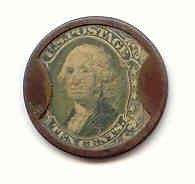 Postage stamps were being used to make change by different proprietors. The problem with using the stamps was that they would easily become discolored, damaged and torn. If they got wet, they would stick together and become useless. Next, stamps were placed in postage envelopes with a specified amount on the outside of the envelope. These envelopes were then passed as a form of currency. Unfortunately, some people tried to deceive others by sealing lesser amounts or plain paper inside these postage envelopes. John Gault, an entrepreneur of the times, decided to make a profit from the shortage of coins that was occuring in the summer of 1862. He decided that there must be a better way of using postage stamps and felt that encased postage stamps would be the answer. He decided that a brass container the size of a regular coin with its front open to show the denomination could be used as coins.
Postage stamps were being used to make change by different proprietors. The problem with using the stamps was that they would easily become discolored, damaged and torn. If they got wet, they would stick together and become useless. Next, stamps were placed in postage envelopes with a specified amount on the outside of the envelope. These envelopes were then passed as a form of currency. Unfortunately, some people tried to deceive others by sealing lesser amounts or plain paper inside these postage envelopes. John Gault, an entrepreneur of the times, decided to make a profit from the shortage of coins that was occuring in the summer of 1862. He decided that there must be a better way of using postage stamps and felt that encased postage stamps would be the answer. He decided that a brass container the size of a regular coin with its front open to show the denomination could be used as coins.
A stamp with its corners folded was placed within the brass frame and a thin sheet of mica was placed over the stamp. The tabs of the brass container were then folded to keep everything in place. John Gault hoped that advertising placed on the reverse would generate his profits. He sold the copper frames to the merchants for a 1-2 cent profit. Merchants warmed to his idea of putting their advertising on the reverse and 31 different vendors decided to advertise on these colorful tokens. The denomination of the stamps used were the 1, 3, 5, 10, 12, 24, 30 and 90 cents.
His patent was issued on August 2, 1862. It was the same time that the use of postage stamps that were used as money was banned in January 1863 by the Federal Government. The idea of encased postage did not last much longer. With the advent of postage currency and fractional notes, the encased postage stamps no longer filled a need. They lasted for several years and most show extensive wear with dents and broken mica.
First issue
The first issue notes, better know as Postage Currency, was authorized in the summer of 1862 and signed into law by the President on July 17, 1862. It was called Postage Currency since these notes resembled stamps. They were issued in 5, 10, 25 and 50 cent denominations. All four denominations came in the following order: straight edge with no monogram, perforated with no monogram, perforated with the ABNCO monogram (American Bank Note Company), and straight edge with monogram. A problem occured with the perforated sheets. The notes came apart and were sometimes damaged during shipping. Because of this, the straight edge notes became the favorite and the production of the perforated notes was short lived. This accounts for the rarity of the perforated notes.
First Issue CFT's
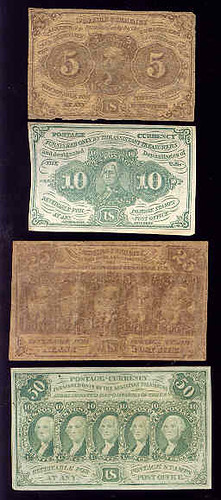 All four denominations of the first issue postage currency were counterfeited. The paper used for the counterfeit notes appears to be thinner than the genuine notes. They had problems duplicating the reverse of these notes. The oval border surrounding the inscriptions in the genuine notes should have a series of distinct white dots in the center of the band. It should be so obvious to catch your eye. In the counterfeit, the band is dark and does not show the series of white dots. The portraits on the obverse of the spurious notes only crudely resemble their intended President. To help cover up the poor engravings of the portraits of some of the 25C notes, wax paper was placed over the obverse of the freshly inked paper to mute the engravings. The notes were also wrinkled and washed to make the note to appear to have been in circulation. Shown to the left are counterfeit examples of each of the denominations in the first issue. Please note the crude faces on each of the notes.
All four denominations of the first issue postage currency were counterfeited. The paper used for the counterfeit notes appears to be thinner than the genuine notes. They had problems duplicating the reverse of these notes. The oval border surrounding the inscriptions in the genuine notes should have a series of distinct white dots in the center of the band. It should be so obvious to catch your eye. In the counterfeit, the band is dark and does not show the series of white dots. The portraits on the obverse of the spurious notes only crudely resemble their intended President. To help cover up the poor engravings of the portraits of some of the 25C notes, wax paper was placed over the obverse of the freshly inked paper to mute the engravings. The notes were also wrinkled and washed to make the note to appear to have been in circulation. Shown to the left are counterfeit examples of each of the denominations in the first issue. Please note the crude faces on each of the notes.
There has been only one variety for the 5C first issue counterfeit identified. It is extremely rare type with only three known examples.
The 10C note has at least five different varieties. Look at the crude engraving of Washington.
For the 25C notes, there are at least nine different types of counterfeits. With the note shown, you can see the result of using wax paper to mute the facial engravings.
The most copied note was the fifty cent denomination with at least twenty different counterfeit varieties. The counterfeiters were going to make more by counterfeiting the higher value note.
To read the complete website, see:
WELCOME TO MY FRACTIONAL NOTES
(http://uns0uled.com/home.html)
COUNTERFEIT FRACTIONAL CURRENCY
(http://uns0uled.com/cft.html)
MEDALLIC ART AS ADVERTISING IN BREWING
Jeremy Bostwick submitted this interesting article about brewing medals and their artistic influences. Thanks! Interesting connections! -Editor
Medallic Art as Advertising in Brewing
By Jeremy Bostwick
In the world of brewing, there is no higher achievement domestically than receiving a medal, especially a first place (gold) medal, in the Great American Beer Festival—an event held annually since 1982 in Denver, Colorado. Despite being American, it nevertheless holds great weight internationally, as the United States has been at the forefront of innovations and inventiveness in craft brewing over the past three decades or so. In a way, more specialized, industry-specific trade shows such as this have taken on the role once filled by international expositions in the earlier part of the 20th or even 19th centuries. Though they still exist, the hype generated from a winning entry at a world's fair was immense in the days of yesteryear, with many companies boasting greatly about their prior win(s), even to the point of adding such a prize to their name and/or advertising.
This concept brings forth two such pieces of exonumia that caught my eye. I have a great interest in medallic art and the many medals associated with numerous world's fairs, while also being an aficionado of craft beers and the history of brewing. In the case of the first medal, that of the Indianapolis Brewing Company, one immediately recognizes not just one, but two familiar designs…
(first image—from the author's collection; the second—a composite courtesy of Stack's Bowers Galleries)
The obverse is a direct copy from the obverse of the official 1900 expo held in Paris and designed by one of the Art Nouveau masters, Jules-Clément Chaplain. Meanwhile, the reverse design clearly channels that of the various official award medals issued just four years later at the next world's fair—that of the Louisiana Purchase expo held in St. Louis, Missouri in 1904. Not only that, the distinctive shape of the design circumscribed within the round shape of the medal conveys that of the grand prize handed out at the aforementioned expo.
So, what to make of this interesting pairing? You'll note that the medal in the first image lacks a date or any other reference to place it. However, a bit of research reveals that the Indianapolis Brewing Company (formed in 1889 after the merger of the Schmidt, Lieber, and Maus Breweries) entered their Dusseldorfer beer into the Paris expo in 1900. For this entrant, the brewery won a gold medal, hence the name which brew thus earned—that of gold medal
beer. Following up their gold medal in Paris in 1900, the brewery then went on to win the grand prize at the St. Louis expo in 1904, perfectly explaining the obverse and reverse iconography of their ensuing promotional medal.
Clearly, this piece of exonumia was meant to promote the accolades received by the brewery for their prized beer, though only someone familiar with the designs of the expo medals themselves, especially many decades removed from such events, would even begin to draw the immediate connection. It's difficult to know if Chaplain or Adolph A. Weinman—famous for the design of the Mercury
dime and Walking Liberty
half dollar, and also for the St. Louis expo medals—knew of this sampling of their works, but I would venture a guess that they did not.
Fast-forwarding just a decade, one undoubtedly recognizes yet another expo medal that was mimicked for the purposes of brewery advertising…
(the first image—from the author's collection; the second—from the author's past inventory)
A "Los Angeles Times" article from 1997 paints the celebrated picture of the Los Angeles Brewery on the centennial of the brewery's founding in 1897. Ten years later, German-born George Zobelein, already well-established within the brewing industry in L.A., ventured out on his own and acquired the brewery. In the 1915 Panama-Pacific expo, Zobelein and his brewery earned a gold medal for "East Side" (sometimes rendered as "Eastside") beer. As mentioned in the article,"...ambitious from the start, Zobelein combined his own recipes with state-of-the-art technology to brew a line of beers, including a pilsener called Eastside, Old Mission Malt, a potent bock and, later, Old Tap Lager." It is very probable that it was this first beer, the pilsener, that garnered the award. So popular was the brew that the Los Angeles Brewery would also go by the name "Eastside Brewery," given the well-known status of the beer.
Similar to the promotional medal issued by the Indianapolis Brewing Company mentioned earlier, the Los Angeles Brewery also sampled the official award medal that it earned, though the latter certainly filled in the details that much better than the former. This medal retains the reverse of the official medal designed by John Flanagan (famous for the Washington quarter), with the familiar façade of the Tower of Jewels prominently reproduced as the focal point, and with the legends following suit as well. Meanwhile, the reverse is a departure, utilizing the space instead to convey more information recounting the award for "excellence of product." Further attesting to the pride exuded for the earning of such a medal, an image of the award itself, reverse and obverse, was used in an advertisement by the brewery in a California-based periodical just a few months after the conclusion of the expo in March 1916...
(advertisement in the March 1916 issue of "The Grizzly Bear")
Though the brewery was later acquired by Pabst Blue Ribbon in 1948 and eventually closed down in 1979, the location nevertheless remains a hub of creativity, now in the form of artist lofts known as "The Brewery." Furthermore, not too far from where Eastside and other beers were brewed by Zobelein, Angel City Brewery has begun to honor that tradition with their "Eastside Series" of beers, "...celebrating L.A.'s brewing heritage" and "...paying homage to the classic beer styles of the early 20th century."
Ultimately, one of the greatest aspects of the fairly expansive world of medals is the stumbling upon nuggets such as these—recognizing what may be, at first glance, rather innocuous iconographic representations, and then making the connection to something more specific within exonumia. No matter what pastimes or leisurely pursuits one may have outside of numismatics, there likely exists a connection to it within numismatics, allowing for the blending of the two and making collecting that much more specific—and rewarding—to the individual collector.
For more information:
https://indyencyclopedia.org/brewing-industry/
https://www.latimes.com/archives/la-xpm-1997-sep-07-me-29791-story.html
https://angelcitybrewery.com/beer/eastside-export-lager/
VOCABULARY TERM: IMPRESSION
Here's another entry from Dick Johnson's Encyclopedia of Coin and Medal Terminology. I added an image. -Editor
Impression. (1) The degree of pressure causing a greater or lesser amount of relief on a struck piece; the impression is gradually increased during set-up until the amount is perfect and the pieces are fully struck up. While impression may be considered how deeply the design is impressed into the metal blank, in reality it is how completely each die cavity has been filled. In effect, that every high point is present and fully formed. Thus pressmen examine sample strikes under magnification for this perfect state of the high points and that no die draw (a flow of surface metal into, then out of, die cavities) has occurred.
Impression. (2) The image on a coin or medal; or its replication by foil, in clay, wax or plaster, as a study copy or private copy. Such copies are created by those people who cannot afford to purchase the originals to study, but still have access to the originals long enough to make replicas. Also such copies are for three-dimensional study where a photograph would not suffice. See copies and replicas.
How to make a foil impression. Use as heavy a foil as can be obtained. Cut a rectangular piece twice as long as wide, ½-inch wider than the coin (1/4-inch margin on each side). Fold the foil in half, place the coin or medal inside covering both sides. Then cover both sides with a thin sheet of hard rubber whose thickness is slightly greater than the height of the relief on the numismatic item.
Then pressure must be applied to this foil/rubber sandwich. The best is a hand press that used to apply a seal (like a notary republic would use). It must be firm yet resilient to the relief on the item. After a squeeze of the hand press, the pressure is released and the sandwich unfolded, removing the coin and foil with the greatest of care. Preserving the foil impression from damage is important as it will deform quite easily. Most foil impressions are kept in albums or in holders intended for coins or medals.
To read the complete entries on the Newman Numismatic Portal, see:
Impression (1)
(https://nnp.wustl.edu/library/dictionarydetail/517304)
Impression (2)
(https://nnp.wustl.edu/library/dictionarydetail/516132
Victoria to Elizabeth II, foil impressions of Pennies (5), 1860, 1862 Pattern with coronet head, 1922, 1933, 1954, in white metal suspended in clear plastic cases [5]. As made, an interesting group £40-£50
To read the complete lot description, see:
Victoria to Elizabeth II, foil impressions of Pennies
(https://www.numisbids.com/n.php?p=lot&sid=5332&lot=328)
THE BOOK BAZARRE
HARVEY STACK'S NUMISMATIC FAMILY, PART 119
Stack's Bowers has a backlog of the late Harvey Stack's numismatic memoir articles and will continue publishing them. In this one Harvey discusses his 1995 Banking and Finance Committee meeting appearance. -Editor
In 1995 there were many signs that the numismatic hobby was growing, from old timers adding to collections or starting new ones, to beginners entering the field for the first time. However, while traditional numismatic collectibles were doing well, there seemed to be less interest in later issues from 1990 to 1995. Proof sets and modern commemorative coins from the Mint saw a drop in orders and sales. As noted earlier, I attribute this decline to overly aggressive policies on the part of the Mint to sell more products at higher prices, when it was evident there was a poor secondary market for these items. In fact, resale value could be as low as 50% of the original costs, a great disappointment to the average buyer who had been led to believe that these special limited editions were great investments. The loss of people who might have become longtime collectors was a loss to the whole hobby.
As a professional in the business, I hated to lose this potential group of collectors, and my outrage was shared by others, often heard at club meetings, conventions, shows and coin shops. I felt that the Mint was not showing much interest in sustaining the market for its products, only in making a large profit at the onset. Having been part of the numismatic hobby for nearly 50 years at this point, I was always looking for ways to attract and keep the interest of the public. I sat down with Congressman Jimmy Hayes from Louisiana, who had been a personal friend and client of mine at Stack's. He said the only way to "tame" the Mint was to let Congress know the poor results of what they had approved in the past and get them to either modify the way the Mint was doing business or stop these profit-making ventures.
This discussion had taken place late in 1994 at a show and, to my surprise, in spring 1995, I was asked to appear before the Banking and Finance Committee of the House of Representatives. My credentials to appear before this group (which had some control over the activities of the Mint) was my being a partner in one of the largest and most prestigious coin firms and having been an active professional numismatist since 1947. In addition, I had represented the coin industry before the government earlier in my career regarding special import licenses and the Hobby Protection Act. I had also been involved in the ANA's process to improve grading standards, served as a commissioner to the last Assay Commission in 1976, and been on the PNG Board of Directors for over a decade, including serving as president of that group from 1989-1991.
In spring 1995 I and other experts in the hobby were summoned to a hearing by the U.S. banking committee to discuss the drop in interest by collectors in Mint products. We were able to provide some monetary history from ancient to modern times and discuss how coins told the story of civilizations, empires, and ways of commerce, reflecting those who ruled, political and social issues, as well as simply being used in daily trade. This background information was well received by the congressmen who attended the meeting. Past President of the American Numismatic Association David Ganz spoke, confirming the drop of interest and membership in our national association, a reflection of the disenchantment brought on by the constant increase in cost of the new commemorative coinage the Mint had produced since 1992. This loss of membership was damaging the goals of the ANA, which were to advance collecting and increase the number of numismatists as well as their enjoyment of the hobby.
I was then asked to speak, as both a professional numismatist and as someone with a great deal of experience working with the collecting public. To my surprise, into the hearing room came Jimmy Hayes, who had been attending another meeting nearby. He asked permission of the chair, Congressman Michael Castle from Delaware, to be the one to introduce me to the committee. After permission was granted, Jimmy spoke of the vast experience I had in the field, and how my family and I had for decades provided a shop in New York, the "club house" as we liked to think of it. It provided a place to gather and to buy, sell and discuss the hobby. He mentioned our history of building and auctioning famous and record-breaking collections and how the business had passed down through generations and was now run by myself and my son Larry. He also mentioned our involvement with coin clubs, both local and national. It was a warm and sincere introduction.
To read the complete article, see:
Growing up in a Numismatic Family: Part 119
(https://www.stacksbowers.com/News/Pages/Blogs.aspx?ArticleID=growing-up-in-a-numismatic-family-part-119)
To read the earlier E-Sylum article, see:
HARVEY STACK'S NUMISMATIC FAMILY, PART 118
(https://www.coinbooks.org/v25/esylum_v25n14a15.html)
CSNS HONORS BETH DEISHER WITH BOWERS AWARD
This press release announces that Central States is presenting its 2022 Q. David Bowers Award to Beth Deisher. -Editor
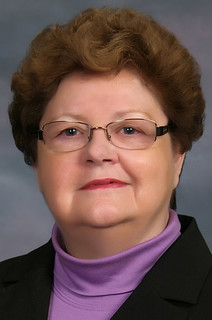 The Central States Numismatic Society is presenting its annual Q. David Bowers Award this year to well-known and respected numismatic journalist Beth Deisher of Sylvania, Ohio. She served as Editor of Coin World for 27 years until her retirement in 2012.
The Central States Numismatic Society is presenting its annual Q. David Bowers Award this year to well-known and respected numismatic journalist Beth Deisher of Sylvania, Ohio. She served as Editor of Coin World for 27 years until her retirement in 2012.
During 2017 and 2018 Deisher served the Industry Council for Tangible Assets as Director of Anti-Counterfeiting, developing and leading a task force that created educational programs and training courses to assist federal law enforcement in the investigation and prosecution of those importing and trafficking in counterfeit coins flowing from China into the United States. In 2019 she led the successful transition of the task force into the nonprofit Anti-Counterfeiting Educational Foundation, now operating under the auspices of the Professional Numismatists Guild.
The annual CSNS Bowers Award recognizes unselfish devotion, scholarly contributions, and investments of time and resources made to the hobby by numismatic professionals.
For whatever reason, the professional side of the hobby is often overlooked when awards and recognitions are handed out. When I proposed the creation of this award in 2019, I thought it important that Central States take the lead in recognizing the contributions made by the numismatic professionals of our hobby,
said Mitch Ernst, CSNS President.
Beth's leadership, and her unrelenting, thoughtful, and trusted work as Coin World Editor, and as the author or editor of important numismatic books, helped build and support a solid foundation for the hobby into the 21st century,
stated CSNS Convention Manager Larry Shepherd. Beth is one of the people I look up to and respect the most in our hobby, for her vast knowledge, her courage, and her unwavering integrity. Her impact on numismatics has been immeasurable.
Named after well-known dealer and prolific numismatic author Q. David Bowers, recipients of the Central States Numismatic Society's annual lifetime achievement award are chosen by the CSNS Convention Committee.
I thank the Central States Numismatic Society for this recognition and for its leadership in the numismatic community,
said Deisher.
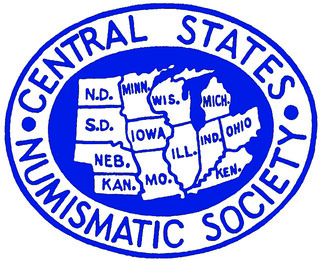
It is especially meaningful to receive its Q. David Bowers Award because Dave Bowers was one of my earliest mentors in numismatics and has remained a great friend for more than 40 years. From Dave and many others within organizations such as Central States, I learned that it's not enough to simply acquire coins, paper money, or medals. Rather, it's sharing the stories of who, when, where, what, and how behind each that brings meaning and purpose to our endeavors. For being accorded the privileges of researching, writing, and getting to know so many interesting and generous people in the numismatic community, I am truly grateful,
she stated.
The 2022 award will be presented to Deisher on Saturday, April 30, during the April 27-30 CSNS convention in the Renaissance Hotel and Convention Center, 1551 Thoreau Dr., in the Chicago suburb of Schaumburg, Illinois.
For additional information about the Central States Numismatic Society and its annual convention visit www.CentralStatesNumismaticSociety.org.
BASS COLLECTION DEPARTS ANA MUSEUM
They say all good things must come to an end. I hope that's not true in every case, but one very good thing for the ANA's Edward C. Rochette Money Museum is indeed ending it's run. This press release announces the withdrawal of the Harry W. Bass, Jr. collection from the Colorado Springs museum. -Editor
The American Numismatic Association (ANA) and the Harry W. Bass, Jr. Foundation announced today that the Harry W. Bass, Jr. collection of U.S. gold coins and patterns on display at the Edward C. Rochette Money Museum in Colorado Springs, Colo., will be returned to the Foundation and sold at auction. The Money Museum has been this collection's temporary home since October 2000.
According to F. David Calhoun, executive director and a trustee of the Harry W. Bass, Jr. Foundation, the Foundation's board of directors recently made the decision to deaccession the Harry Bass Core Collection (HBCC) – the celebrated coin collection that Harry W. Bass, Jr. assembled – in order to concentrate on funding Dallas-area nonprofit organizations, with specific emphasis on early childhood education and literacy programs.
The decision was bittersweet,
Calhoun said. I've been associated with Harry's collection since the 1970s. But this move will allow us to more than double our annual philanthropy budget. For a lot of nonprofits we've had to say
no
to previously, we'll now be able to say yes
. Every cent that the core collection brings at auction will go to philanthropy.
According to Calhoun, the Harry Bass Core Collection is valued at a minimum of $50 million.
A businessman, coin collector and philanthropist, Dallas resident Harry W. Bass, Jr. (1927-1998) created one of the most complete U.S. gold coin collections ever assembled, including many one-of-a-kind specimens. Of paramount importance is a set of virtually all known die varieties of early (1795-1834) U.S. gold coin denominations ($2.5, $5, and $10) in the finest condition. The exhibit also features the only complete collection of $3 gold pieces, including the unique 1870-S; a complete type set of U.S. gold coin designs from 1834 to 1933; and a spectacular grouping of rare U.S. pattern coins.
We have had the privilege and honor of providing a numismatic home for the Harry Bass Core Collection for nearly 22 years,
said ANA Executive Director Kim Kiick. We are beyond thankful to the Foundation for allowing the ANA and the Money Museum to showcase this outstanding assemblage in a magnificent gallery these many years.
The Harry Bass Core Collection will remain on exhibit at the Money Museum through June 2022. According to Kiick, the Foundation has expressed interest in assisting the museum's efforts to retrofit and redesign the current Bass Gallery for a new exhibit by way of a grant.
The Bass family, led by Harry Bass, Sr., created and developed numerous oil and gas interests spread across five states, and the proceeds from these investments have funded many philanthropic ventures. For a number of years prior to his death in April 1998, Harry W. Bass, Jr. administered two nonprofit foundations. The first, the Harry Bass Foundation, established in 1945, was created by his father to provide support to a number of Dallas charitable and religious institutions, as well as hospitals and museums. A second foundation, the Harry W. Bass, Jr. Research Foundation, was created in 1991 as an extension of the younger Mr. Bass's great interest in numismatics and his desire to engage in significant philanthropic endeavors in different areas. Following the death of Harry W. Bass, Jr., the two independent foundations merged to form the Harry W. Bass, Jr. Foundation to enrich the lives of citizens of Texas by providing support to qualified organizations in the areas of education, human services, civic and community, science and research, and arts and culture.
The Harry W. Bass, Jr. Foundation has selected John Dannreuther to be the representative managing the deaccession of the collection. Dannreuther will handle review and selection of an auction house and third-party grading service, along with other ancillary issues.
For more on the exhibit, see:
Experience One of the Greatest U.S. Gold Coin Collections Ever Assembled
(https://www.money.org/money-museum/Harry-W-Bass-Gallery)
HOLABIRD APRIL 2022 SALE SELECTIONS
Here are some lots that caught my eye in the upcoming Holabird sale. -Editor
The very popular one ounce silver round with a gold panning miner dubbed "The American Prospector" made by Engelhard.999+ fine silver, in hard plastic case with a tiny gold nugget added to the miner's pan. City: State: Date:1984
We recently discussed impressed medals - see the link for more. -Editor
To read the earlier E-Sylum article, see:
VOCABULARY TERM: IMPRESSED DESIGN
(https://www.coinbooks.org/v25/esylum_v25n14a13.html)
To read the complete lot description, see:
Engelhard American Prospector Silver Round with Gold Nugget [148127]
(https://holabirdamericana.liveauctiongroup.com/Engelhard-American-Prospector-Silver-Round-with-Gold-Nugget-148127_i44777504)
Lot of three: 1) 1934 German piece with swastika; 2) L. N. Tolstoy 1828-1910. Tribute from V. I. Lenin, 29 November 1910 (includes translation); 3) M. Lermontov 1814-1841. Mikhail Yuryevich Lermontov was a Russian Romantic writer, poet and painter, sometimes called "the poet of the Caucasus",
Some nice medals. -Editor
To read the complete lot description, see:
German/Russian Medals [145505]
(https://holabirdamericana.liveauctiongroup.com/German-Russian-Medals-145505_i44777599)
An unusual political item dated 1953. Appears to be a one-off item made in a machine shop from a large steel washer. A circulated 1944 Lincoln cent is encased in the center. The obverse reads, ONE REPUBLICAN DOLLAR / 1953, perhaps referring to the recession of 1953 largely the result of restrictive monetary policies of the Federal Reserve hoping to stave off anticipated inflation. The reverse reads, IN IKE WE TRUST / NIXON DON'T LIE. This enigmatic piece reminds one of the large Bryan Dollars produced in 1896. Worthy of further research. Stell, 64 mm, EF. City: State: Date:1953
And Nixon ain't a crook, neither. Very interesting piece! Definitely worth more research. Does it appear in any catalogs of encased cents? -Editor
To read the complete lot description, see:
One Republican Dollar [146828]
(https://holabirdamericana.liveauctiongroup.com/One-Republican-Dollar-146828_i44777645)
Rare Token of Esteem issued by the Pacific Coast Numismatic Society commissioned by members Harvey L. Hansen and Ernest R. Wenstrom. They were distributed at the PCNS meeting on December 10, 1930, at the Society dinner meeting at the Splendid Grill in the San Francisco Hotel Whitcomb. The token honors Farran Zerbe as the founder of the PCNS. Unknown mintage, but the token is rare. Aluminum 30.5 mm, Unc. City: State: Date:1930
Interesting and rare piece of numismatic Americana. I'd never seen one of these before. -Editor
To read the complete lot description, see:
Pacific Coast Numismatic Society Token [146839]
(https://holabirdamericana.liveauctiongroup.com/Pacific-Coast-Numismatic-Society-Token-146839_i44777646)
Almost uncirculated example of the famous pictorial token. GOOD FOR / 10¢ / IN TRADE / ART SALOON / 1356 / MARKET ST. S.F. / L.H. MOISE. S.F. // SOUVENIR JAP STATUE (statue wearing fig leaf); Br., rd., 34 mm. Art Saloon, Thomas P. Dunne proprietor, 1356 Market (1897-1899) The statue is of Hananuma Masakich, who carved it into an exact likeness of himself, using his own hair, nails and teeth to complete its realism. (tokencatalog.com) Ex Ron Lerch collection. City:San Francisco State:California
Creepy! -Editor
To read the complete lot description, see:
Art Saloon Token [142470]
(https://holabirdamericana.liveauctiongroup.com/Art-Saloon-Token-142470_i44777703)
N.C.O. OPEN MESS / INDIAN / SPRINGS / AUX. / FIELD / NEVADA // GOOD FOR / 1.00 / IN TRADE; Br. Sq. 28 mm. City:Indian Springs State:Nevada Date:
Nice military token. -Editor
To read the complete lot description, see:
N.C.O. Open Mess Token [140963]
(https://holabirdamericana.liveauctiongroup.com/N-C-O-Open-Mess-Token-140963_i44777758?t=HEBApr9)
Bryan Dime, Schornstein 345 (Zerbe 46): // BRYAN'S / IDEA OF / COINAGE // struck token. The obverse seems to be a play on a Spanish accent: // TENO / CENTO // with a wreath. The surround inscription reads // FREE SILVER / THE BRYAN IDEA //. Type Metal (lead alloy), 44m, AU. City: State:Ohio Date:
I hadn't seen this "TENO CENTO" type before. -Editor
To read the complete lot description, see:
Bryan Dime, Zerbe 46 [144617]
(https://holabirdamericana.liveauctiongroup.com/Bryan-Dime-Zerbe-46-144617_i44777805)
For more information, see:
https://www.holabirdamericana.com/
THE FRED WEINBERG COIN DIE COLLECTION
On May 2, 2022 Heritage is offering the Fred Weinberg Coin Die collection. Here are some lots that caught me eye. -Editor
Undated Continental Dollar Restrike Reverse Die Uncertified.
Which restrike is this, though? -Editor
To read the complete lot description, see:
Undated Continental Dollar Restrike Reverse Die Uncertified. . From The Fred Weinberg Collection.
(https://coins.ha.com/itm/so-called-dollars/undated-continental-dollar-restrike-reverse-die-uncertified-from-the-fred-weinberg-collection/a/63183-91246.s)
1910 Pennsylvania State Memorial Souvenir Medal Reverse Master Die Uncertified. Designed by French Sculptor Jules Edouard Roine'.
To read the complete lot description, see:
1910 Pennsylvania State Memorial Souvenir Medal Reverse Master Die Uncertified. Designed by French Sculptor Jules Ed...
(https://coins.ha.com/itm/20th-century-tokens-and-medals/1910-pennsylvania-state-memorial-souvenir-medal-reverse-master-die-uncertified-designed-by-french-sculptor-jules-ed/a/63183-91249.s)
(1887) Fourth Annual Reunion Token Die, West Union Iowa, Uncertified.
To read the complete lot description, see:
(1887) Fourth Annual Reunion Token Die, West Union Iowa, Uncertified.. From The Fred Weinberg Collection.
(https://coins.ha.com/itm/miscellaneous-medals-and-tokens/-1887-fourth-annual-reunion-token-die-west-union-iowa-uncertifiedfrom-the-fred-weinberg-collection/a/63183-91251.s)
(1855-1955) Lachen Schützengesellschaft Centennial Die Uncertified.
To read the complete lot description, see:
(1855-1955) Lachen Schützengesellschaft Centennial Die Uncertified. . From The Fred Weinberg Coll...
(https://coins.ha.com/itm/germany/-1855-1955-lachen-schutzengesellschaft-centennial-die-uncertified-from-the-fred-weinberg-coll/a/63183-91255.s)
PETER RAPP MAY 2022 SALE
Here's a press release with some highlights of the May 6, 2022 sale by Peter Rapp AG in Switzerland. -Editor
On 6 May 2022, Rapp will hold its numismatic auction sale. Connoisseurs can look forward to individual specimens as well as collections, including lots with bullion gold. The numismatic auction is one of many highlights of Rapp's auction week with stamps, watches, jewellery and more.
In the first week of May, the idyllic St Gall town of Wil in Switzerland will once again become a meeting place for coin collectors. In the afternoon of 6 May 2022, Rapp's numismatic auction will take place. It is part of Rapp's auction week that comprises a wealth of items, which are presented in six auction catalogues: The sale starts with high-class stamps and outstanding philatelic objects, which will be on sale from 2 to 4 May. This will be followed by two auctions of watches and jewellery on 4 and 5 May. The 6 May is reserved for numismatics. The auction week will close on 7 May 2022 with two online auctions for porcelain, jewellery, watches and luxury handbags.
As always, customers can look forward to an offer that only comprises fresh pieces that come directly from collectors. Collections and precious individual items are looking for new owners. Those who cannot come to the viewing can study the material in Rapp's online catalogue. Entire collections were completely digitised solely for this purpose, enabling anyone to find out which treasures the lots contain. Rapp deliberately does not separate interesting objects but offers them as multiple lots.
The Rapp Concept
Specialists call this approach the Rapp concept
, which has also established itself in the
traditional coin trade in recent years. It's clear why this is an advantage to the buyer: they
receive fresh, unsorted goods with exciting pieces. And sellers are also happy with this
method. After all, not a single lot is sold for the starting price at a Rapp auction sale – on the
contrary. Expect to have to bid many times the starting price to get one of the coveted lots.
This is due to the large group of buyers that gathers for every Rapp auction in Wil. For Rapp knows what collectors want. That's why Peter Rapp and Marianne Rapp-Ohmann made their auction sales a social event. The culinary delights in the Rapp Collectors Lounge are legendary. Rapp made use of the quiet time during the past two years to make everything even more beautiful. Bidders can unwind in this exclusive space with the finest champagne and a premium wine selection.
Rapp auctions have style, and customers value that. Many people who appreciate beauty of any form gather for the Rapp auction week and participate in the bidding – and not just regarding objects of their main field of interest. After all, are there really collectors who are only interested in one single field?
((4378 – An interesting selection of 113 gold and 2 platinum world coins, issued by the BW Bank on a subscription basis. Original sealing. A total of more than 530g of pure gold, 10.9g of platinum. Starting price: CHF 5,000))
A Special Kind of Bullion Coins
That's why bullion coins realise especially attractive results at Rapp. The offer is large, the
possibility to combine investing and collecting by purchasing one of the extensive lots is
highly interesting. Especially in uncertain times like ours, many people rely on bullion coins
to protect their assets.
So come to view the lots and choose the one you consider most exciting. But remember: viewing the items at Rapp requires an appointment! There is no exception. You can make your appointment online or simply call the auction house.
((4018 – German Empire. Bavaria. Ludwig III. 20 marks 1914D. J. 202. Extremely fine to FDC. Estimate: CHF 3,000 to 5,000))
Numismatic Treasures from Antiquity to the Present Day
Peter Rapp will auction a total of 381 lots with coins, medals and banknotes in the afternoon
of 6 May 2022. The pieces cover a spectrum from antiquity to present times and come from
all over the world. The special focus is on Swiss coins and medals, a section that comprises
150 lots exactly. But there are also many issues from the neighbouring countries Austria,
Liechtenstein and Germany – especially from Bavaria.
And this takes us to the presentation of some particularly attractive individual pieces. For example, Rapp offers the last Bavarian gold coin of outstanding quality, minted by Ludwig III in 1914. It represents an extensive offer, which also includes older Bavarian silver coins and large selections of geschichtstalers (history talers), which contains rare and high-quality specimens of this series.
((4056 – Liechtenstein. John II 1858-1929. 20 kronen 1898, Vienna. About FDC. Estimate: CHF 1,500 to 2,500))
((4150 – Bern. Golden medal of merit of 16(?) ducats n.d. (1730) by J. Dassier. 2nd known specimen of this weight? Estimate: CHF 4,000 to 7,000))
One of Rapp's Specialties: Swiss Numismatics
We already said it: Switzerland is represented by 150 lots. To get a better idea of the wealth
of the offer, you have to keep in mind that some of the lots comprise entire collections. The
material ranges from A as in Appenzell to Z as in Zurich. Collectors will find Swiss talers as
well as rare gold coins, ornate medals and vrenelis.
Especially those interested in Bern will discover magnificent rarities, particularly in gold.
There's a lot to see: from an extremely rare 1797 eightfold ducat(!) of exceptional quality to splendid medals of merit. Particularly interesting is the medal made on behalf of the Council of Bern in 1730 for Lieutenant Henchoz, which depicts Androclus and the Lion. The image illustrates a Roman fable, which was readily used to express gratitude. The medal with a weight of 52.27g seems to be the second known specimen of this weight. Eisler's standard work cites only one other specimen; the sixbid archive does not know another piece of this weight either.
((4131 – Bern. Eightfold ducat 1797. Off-metal strike in gold of a half taler. Estimate: CHF 30,000 to 40,000))
((4154 – Helvetic Republic. 32 francs 1800 B. Magnificent quality. Estimate: CHF 7,500 to 10,000))
The coins of the Helvetic Republic were also created in Bern. This short-lived state on Swiss soil came into being on 12 April 1798 on the orders of revolutionary France to replace the Old Swiss Confederacy. Its coin motifs, on the other hand, do not seem to be that revolutionary. They resemble the motifs of the last Bern gold coins with the standing warrior.
((4176 – Swiss Confederation. 5 francs 1928B. First strike. Beautiful patina. Estimate: CHF 16,000 to 22,000))
Another numismatic highlight is a fine collection that was assembled over decades and
contains 5 franc pieces (or Fünfliber
pieces as the Swiss say) from the years between 1850
and 1928. The collector paid great attention to quality. Therefore, the 5 franc piece of 1928 is
probably one of the pieces of the best quality that still exist today – only 23,971 specimens
were minted of this coin type and almost as many melted down again. There is a good reason
why the minted specimens were destroyed. The Latin Monetary Union had already come to
an end one year earlier; now Switzerland could adjust the precious metal content of its silver
coins to the real value ratios without consulting foreign powers. For the continuation of the
series in 1931, size and weight were reduced.
((4186 – Swiss Confederation. 20 francs 1871, Durussel pattern, Bern. Estimate: CHF 25,000 to 30,000))
At least as rare – if not rarer – is the so-called Durussel pattern
, a pattern for a new 20 franc
piece of the Confederation from 1871. In his reference work on Swiss patterns, Richter
mentions about 25 to 30 minted specimens. In fact, Swiss policymakers decided not to mint
any gold coins at the time and to rely on silver from then on. Switzerland only started to mint
gold issues in 1883.
The Durussel pattern is one example for several extremely rare patterns of Swiss issues in this
auction. On offer are the Wiener pattern
and two Drei-Punkt-Proben
(three dot patterns).
Some rare error coins take us to Swiss medals and shooting talers with extensive series of
19th- and 20th-century medals.
((4282 – USA. 20 dollars 1871 CC, Carson City. NGC AU53. Estimate: CHF 15,000 to 35,000))
Rarities from Europe and Overseas
In this preview, we will only mention two examples to illustrate the fact that collectors of
coins from other countries should also study the catalogue carefully. Rapp offers an extremely
rare 20 dollar piece from 1871 minted in Carson City / Nevada.
It will probably prove to be just as sought after as an even rarer 5 ducat piece depicting St
Wenceslas, minted in 1931 in the Kremnica mint – the issue was limited to 1,528 specimens.
What Else Should You Know?
As you can see, it's well worth coming to Wil. And – finally – in person. For Rapp offers
enough space to keep your distance in its spacious premises and its auction room of more than
140 square meters. Large automated disinfection dispensers are at your disposal. Currently,
there are no Covid restriction in place in Switzerland. Thus, you do not have to show any
certificate. We will inform you on our website regarding possible changes.
Please note, however, that you must make an appointment for the viewing. For security reasons, there are only limited places available. If you come without an appointment, Rapp cannot guarantee that you will be able to view the pieces and you probably have to wait for a long time.
And for all those who prefer to bid from home: auction house Rapp has more than ten years of experience with online bidding and online sales. Thousands of customers have tried it and are highly satisfied. Thus, bidding from your computer at home is a valid option, although you can only experience a small part of Rapp's special VIP service if you choose this option.
Order Your Catalogue
You can order your catalogue at Peter Rapp AG, Internationale Auktionen für Briefmarken &
Münzen, Toggenburgerstr. 139, post box 276, CH-9500 Wil, phone: +41 / 71 / 923 77 44; fax:
+41 / 71 / 923 92 20. email:
info@rapp-auktionen.ch.
For more information about the sale visit
www.rapp-auktionen.ch
NUMISMATIC NUGGETS: APRIL 17, 2022
Here's a selection of interesting or unusual items I came across in the marketplace this week. Tell us what you think of some of these. -Editor
(x) NGC VF35 | James I (1603-1625), First Coinage, Crown, 24 March 1603 - 22 May 1604, Tower, (m.m.) • IACOBVS • D .' G .' ANG .' SCO .' FRAN .' ET • HIB .' REX •, King on horseback trotting right, ground line below, rev. (m.m.) • EXVRGAT • DEVS • DISSIPENTVR • INIMICI •, square-topped and lightly garnished shield, 29.59g, 2h, m.m. thistle (FRC II/III, lot 17; North 2070; Spink 2643),
A nice James I Horseman crown offer by SPINK in the upcoming David Hoover Collection of Crowns: 1551-1953. -Editor
To read the complete lot description, see:
NGC VF35 | JAMES I (1603-1625), FIRST COINAGE, CROWN, 24 MARCH 1603 - 22 MAY 1604, TOWER
(https://live.spink.com/lots/view/4-5NW51J/ngc-vf35-james-i-1603-1625-first-coinage-crown-24-march-1603-22-may-1604-tower)
Pleasing Small Eagle Dollar has a touch of pretty blue/green in stars 5-6-7. No recent trades in 30 but 35's bring 7500-8500! Small eagle dollars are under rated.
I noticed this one in the stock of Harry Laibstain Rare Coins. Nice type coin that's seen cirulation, but still looks nice. -Editor
To read the complete lot description, see:
1797 $1 9X7 LARGE LETTER *** PCGS VF30
(http://hlrc.com/Inventory/CoinViewer?id=870605001&c=23)
US Draped Bust Large Cent (1796 - 1807)
Countermarked "WM / REED" (in a very decorative style)
The mark is too large to fit on the coin. It is stamped twice in a fashion that makes it easy to read the name. Raised letters within a serrated rectangle. The "M" of "WM" is small and raised above a decorative design. This is one of the neatest maker's marks that I've seen. I have seen at least one other of these countermarks (in 2006 or 2007).
There are two gunsmiths named William Reed listed in Sellers (American Gunsmiths), page 249. This piece may have been issued by one of them.
Possibility: REED, William -- Gunsmith, 11 Water Street, Baltimore, Maryland, 1802.
Brunk R-157.
Bob Merchant is offering an interesting merchant counterstamp on eBay this week - an unusually large stamp on a very worn Draped Bust Large Cent. -Editor
To read the complete lot description, see:
US Draped Bust Large Cent, Counterstamp "WM REED" (William Reed)
(https://www.ebay.com/itm/134081682511)
This item has been sold. These are typically made with smaller coins. Interesting engraving on a Morgan dollar. Perhaps a souvenir of a couple's 25th anniversary. -Editor
To read the complete lot description, see:
Lot 595: Victorian Love Token / Silver Dollar
(https://www.invaluable.com/auction-lot/Victorian-Love-Token-Silver-Dollar-595-c-A1A469FBBD)
(t) CHINA--PROVINCIAL BANKS. Kwangsi Bank. 5 Yuan, 1909. P-S2346. PMG Choice Fine 15 Net. Repaired, Severed & Reattached.
(S/M#K36). This is an exciting opportunity to acquire one of the most desirable and coveted pieces of World Paper. Among the most significant Chinese pieces in all of numismatics, this "Black Dragon" note is the sole graded on PMG's census and without question the finest & only example we have ever handled for this denomination. The design features facing black dragons protecting a vignette of five 1 Dollar Kwangsi coins. The pearl of wisdom is found at upper center. The back of the note features a green border design, with characters at center.
The incredible history of the note can be traced back to when the Qing Dynasty changed the structure of both Imperial Banks and made Kwangsi the first province to establish their own bank. The printing of the note took place in Japan. The notes were only in circulation for 2 years, and after being summoned back at that time, so few have survived.
This one caught my eye for the images of coins. Banknotes picturing coins are a popular genre of collecting. In the U.S. there are quite a number of pre-Civil War scrip notes picturing the Spanish coins common in cirulation at the time. From the Stack's Bowers May 2022 Hong Kong Auction - Session A - Chinese, Hong Kong & Foreign Paper Money. A pricey piece estimated at $100,000 - $150,000. -Editor
To read the complete lot description, see:
(t) CHINA--PROVINCIAL BANKS. Kwangsi Bank. 5 Yuan, 1909. P-S2346. PMG Choice Fine 15 Net. Repaired, Severed & Reattached.
(https://auctions.stacksbowers.com/lots/view/3-VUF33/t-china-provincial-banks-kwangsi-bank-5-yuan-1909-p-s2346-pmg-choice-fine-15-net-repaired-severed-reattached)
ANCIENT COINS OF THE KINGDOM OF SOPHENE
If you're like me, you've learned far more about history and geography from numismatics than you ever did in school. This article by Steve Benner for CoinWeek is a great example. Check it out to learn about the Kingdom of Sophene. Here's an excerpt - see the complete article online for much more. -Editor
The Kingdom of Sophene is another one of those ancient countries that has not received very much attention from ancient coin collectors. Usually, it is just lumped in with Armenia because it was absorbed into the Armenian Empire by Tigranes II the Great (140–55 BCE) after 95 BCE. But Sophene had its own unique history and distinctive coinage.
The name Sophene comes from the ethnonym Suppani, a people who lived in the region dating back to the first millennium BCE; this area is now southeast Turkey. The terrain is quite mountainous and is crisscrossed by numerous rivers, creating river valleys that are very productive in spite of the harsh winters and hot, dry summers. The region was part of Urartu (Ararat) in the eighth and seventh centuries. Argishtis I of Urartu built the city of Erebuni (modern-day Yerevan) and resettled many of the inhabitants of the locality in the new city.
Several rules and their coins are discussed. Here's a rare coin of Xerxes. -Editor
A lot more is known about the reign of Xerxes, a son of Arsames I. He succeeded to the throne in 228, and his brother Orontes IV was the ruler of Armenia. In 223, several satraps of the Seleucid Empire rebelled against King Antiochus III, but most of the rebellions had been suppressed by 220. Antiochus invaded Sophene and besieged the main city of Arasomata. After Xerxes was defeated, Antiochus had his sister Antiochis marry Xerxes (what would he have got if he had won?). Within a year, she had arranged the assassination of Xerxes, opening the way for her brother to take over the kingdom. Antiochus installed an Armenian General, Zariadres, as the governor of the region.
Figure 5: KINGS of SOPHENE. Xerxes. Circa 220 BCE. Æ 19. Diademed and draped bust right, wearing folded tiara; monogram to left / Nike standing left, holding wreath; monogram to inner left ??S???OS [??????], 19mm, 5.08 g., Bedoukian, Coinage 9. (CNG 85, Lot: 6, $2200, 9/15/10).
Coins of Xerxes are very rare. Figure 5 shows the only photo of a coin of this king that I could find. It has the profile of the bearded king facing right on the obverse, and the reverse has Nike standing left holding a wreath. The legend on the reverse is ??S???OS [??????], King Xerxes.
The British Museum has three Xerxes coins; one has the same reverse and the other two have Athena standing left holding a wreath in her right and her left hand resting on a shield.
To read the complete article, see:
Ancient Coins of the Kingdom of Sophene
(https://coinweek.com/ancient-coins/ancient-coins-of-the-kingdom-of-sophene/)
1714 GLOUCESTER SHILLING
"A rarity of the highest order", says the catalog, and I have to agree. With only two known examples, the Gloucester 'Shilling' is about as rare as they come. Offered by Heritage in their upcoming May 4-8 2022 Central States sale. From The Long Island Collection, Part III. -Editor
1714 Gloucester Shilling Fine 12 NGC. Breen-237, W-8180, R.8. Ex: Long Island Collection. The 1714 Gloucester shilling is an issue collectors come to know through osmosis, generally after years of flipping through the pages of the annual Guide Book. It is not an issue they are ever likely to have encountered "in the wild." The example offered here, last seen publicly 40 years ago, is one of only two pieces known to the numismatic community.
Sylvester Sage Crosby documented the 1714 Gloucester shilling in his 1875 opus, Early Coins of America, where he wrote:
"Of the history of the earliest of these, called the Gloucester Token, nothing is known. It appears to have been intended as a pattern for a shilling of a private coinage, by Richard Dawson of Gloucester [county?] Virginia. It is probable that no tokens of this intended issue were actually put in circulation, as we find no specimen in silver. But two specimens of this are known, both struck in brass. A full description cannot be given of it, as both impressions are very imperfect, and together they do not supply the entire legends with certainty."
It was not until 1976 or shortly thereafter that one of the two examples (ex: Appleton) was found to be a cast counterfeit. As luck would have it, this piece turned up a couple of years later. In its only public appearance to date, the Bowers and Ruddy cataloger explained the circumstances surrounding its discovery:
"It was discovered around March, 1981 when a Gloucester resident mentioned to a neighborhood woman that he was a coin collector. The woman, who like the collector prefers to remain anonymous, told the collector that she had some coins and offered to sell them. The local collector weighed the coins and paid her as though all of the pieces were .900 fine silver. Actually, there was a mixture of material, what is often called a 'dresser drawer accumulation.'"
The collector eventually identified the token, which was authenticated by the International Numismatic Society Authentication Bureau, and he and the original owner partnered in bringing the coin to auction. Not only did the discovery of this example bring the population of Gloucester tokens back up to two, it also helped clarify the issue's origins. The legends and devices on each of the two known examples are incomplete, but by comparing them, a more complete picture emerges. The obverse depicts a building with chimneys at both ends and XII below. Around the obverse is the legend, GLOVCESTER COVRTHOVSE VIRGINIA. The central reverse motif is a pentagonal star with the legend ANNO DOM 1714 RIGHAVLT DAWSON around. According to the Bowers and Ruddy cataloger, William DeHardit, editor of a local newspaper in Gloucester County, stated "that a family with the last name Righault owned land near the Gloucester Courthouse, the structure believed to be depicted on the obverse of the token. The land was granted to Christopher Righault in 1654 by the Virginia Land Office." According to DeHardit, "[t]he name Dawson is associated with the Abingdon Church section of Gloucester County."
Crosby described the Gloucester token as "a pattern for a shilling" that was never put into circulation. The Bowers and Ruddy cataloger contends: "As tobacco was the legal currency then in Virginia, the token must have functioned as some kind of warehouse receipt or scrip issue. There is no reason to assume, as some have done, that it represented a pattern for a silver coin or a substitute for silver."
Opportunities to acquire such a rarity come along maybe once a generation. It will be interesting to see the competition come auction day. -Editor
To read the complete lot description, see:
1714 Gloucester Shilling Fine 12 NGC. Breen-237, W-8180, R.8....
(https://coins.ha.com/itm/colonials/1714-gloucester-shilling-fine-12-ngc-breen-237-w-8180-r8/a/1344-3676.s)
DUTCH EAST INDIES COINAGE
Stack's Bowers Numismatist for World and Ancient Coins Nicholas Fritz published a blog article on Dutch East Indies coinage, including the Dutch East India Company pieces. A number of Dutch East Indies rarities will be offered the firm's May Hong Kong Sale. -Editor
The Dutch Colonial Empire is often forgotten when compared to the larger empires of the British, French, and Spanish. However, the Dutch Empire has left a legacy that can be seen in some unexpected places. One of the official languages of South Africa is Afrikaans, which derives nearly all its words from the Dutch language, highlighting South Africa's Dutch Colonial past. Manhattan Island was purchased by Dutch explorer Peter Minuit for 60 Guilders in 1626, despite the concept of private property ownership being unknown to the Native tribes inhabiting the Island and the surrounding area.
What is now Lower Manhattan in New York City was a Dutch colony until 1664, when it was formally brought into the British Empire. Traces of Dutch language and culture remained in New York for many years after the formal end of New Netherland, with Dutch speaking villages remaining well into the 19th century. In one of these, Martin Van Buren was born, making him the only president of the United States who spoke a native language other than English. On the other side of the world, the Dutch East India Company began setting up outposts, forts, and trading towns in Southeast Asia in the early 17th century, with this influence lasting until the end of the Second World War.
The Dutch Empire was primarily focused upon establishing an economic trade network to generate wealth, rather than gobbling up large land areas for exploitation. This focus was an effort to confine colonized areas and limit costs, much as a large multinational corporation would today. The early origins of the Dutch Empire are found in a private corporation: The Dutch East India Company. The Dutch East India Company was the first corporation to ever be publicly traded on a stock exchange and is sometimes regarded as the largest corporation to ever exist. At the height of its power, the Dutch East India Company rivaled nations, with economic power that was unmatched. While a private company, the Dutch East India Company was a state-backed enterprise, with military support. By the end of the 17th century, this company's primary base of operations was in the Netherlands East Indies, which acted as a profitable trading center between the Orient and Western European powers. This role led to great wealth and power for both the Dutch East India Company and the Netherlands more generally.
It was during this period of Dutch East India Company rule, which lasted until 1800, that the first coinage was produced in the area. This company coinage began in 1726 with the denominations of the Duit, Ducaton, and Gulden forming the basis of the currency. In addition to circulation strikes, patterns were produced in gold and specimens in silver for the Duit. In the May Hong Kong Sale Stack's Bowers Galleries will be offering an example of each, with a 1749/7 PCGS Specimen-62 Silver Duit and a 1761 Gold ½ Duit Pattern providing exceptional eye appeal with the off-metal strike, despite the NGC UNC Details Designation.
By 1806 the political situation had shifted, with the Netherlands being under the control of the French and Napoleon Bonaparte. The Dutch East Indies fell sway to French domination as well, with Dutch control not formally reestablished until 1816, with the final defeat of Napoleon at Waterloo. After 1816, the Dutch East Indies was established as a proper Dutch Colony, under direct control of the Netherlands, and legally distinct from the Dutch East India Company. Over 100 years, the Netherlands established a firmer grasp of all of the Islands that now encompass Indonesia.
Coinage was standardized and decimalized, bringing it in closer accord to the Netherlands Guilder that circulated in the Netherlands. Minting was additionally centralized in Utrecht, as before, and mintage varied between mints. While circulation coinage from this period is often abundant, proof issues had very limited production and are hard to find. The May Hong Kong Auction offers many proof examples and is one of the most numerous groups to come to market recently. All denominations except the 1/2 and full Gulden are represented in proof in the sale, including a 1/4 Gulden from 1854, graded PCGS Proof-64 and a 1/10 Gulden, also from 1854 and graded PCGS Proof-64.
As with the other European colonial possessions in East Asia, the Netherlands East Indies were occupied by the Japanese in Second World War to capitalize on the colony's oil reserves and rubber production facilities, vital resources for the Japanese war effort. After the Japanese occupation, the Netherlands attempted to reassert control of the former colony, but a revolutionary movement in addition to opposition to old European empires by the United States and Soviet Union left the end of colonial status of the territory inevitable. The boundaries of the Dutch East Indies now comprise the nation of Indonesia. Though the colony ended, colonial coins from both the East India Company and Netherlands period remain popular among collectors, who are sure to be pleased with the offerings in the May Hong Kong Sale.
These highlights, along with over 7,500 other Asian related coins will be available for viewing and bidding at StacksBowers.com.
To read the complete article, see:
Dutch East Indies Rarities to be Offered in May Hong Kong Auction
(https://www.stacksbowers.com/News/Pages/Blogs.aspx?ArticleID=dutch-east-indies-coins-in-may-2022-hk-auction)
COPPER 1839 GOBRECHT DOLLAR JUDD-107 RESTRIKE
A great Gobrecht dollar pattern is coming up for sale. -Editor
1839 P$1 Name Omitted, Judd-107 Restrike, Pollock-119, Unique, PR65 Brown PCGS. Ex: Simpson. Copper. Plain Edge. Stars Obverse, No Stars Reverse. Die Alignment III (head of Liberty opposite the N in ONE). Die State A. Judd-107 is essentially a Judd-105 struck in copper. While struck in different metals, both the Judd-105 and 107 share the same starless reverse and plain edge. The reverse die cracks are microscopic, but located left of M and extending through MERI terminating to the right of I, connecting the tops of NITED, and through the bottom of LAR. The die spur on the right side of the D in UNITED is also present as well as the depression in the field below and to the right of the F in OF. Several stars on the left side of the obverse are double-punched: star 3 slightly, 5 and 8 (both show considerable rotation). This is the same star repunching as seen on Judd-104s. At the microscopic level there is pimply evidence of die rust, undoubtedly from using a 30-40 year-old pair of dies.
The die state of this piece is similar to that on the later state 1839 Judd-104 restrikes, Judd-105, and all the other mules. These other starless reverse issues as well as all other Gobrecht mules show the same die spur on the right side of the D in UNITED. Judd-64, 87, and 107 all show the same field depression below and to the right of the F in OF, which is believed to be from foreign matter that adhered to the die at the time of striking. This depression is not seen on any silver Gobrecht dollars, and its presence on these three copper issues suggests a common striking period. There is an interesting annotation in Samuel Chapman's copy of Adams-Woodin as quoted in the Champa II Sale (Bowers and Merena, 3/1995). Next to AW61-63 Chapman noted, "Mules by the Snowden-Thatcher (?) gang 1874-1880." This is the equivalent of AW-87, but the point is still taken that mules (generally speaking and not just limited to those dated 1838) were struck in this 1874-1880 time frame.
This coin appears to be unique. No other example has surfaced since this coin was first sold at public auction in 1908. To further underline the significance of this unique dollar, it was one of only two Gobrecht issues and mules missing from the fabulous collection assembled by the late Dr. Julius Korein, whose collection was donated to the ANS and remains there. This piece has only been one other time at public auction since 1972, and thus was never on the market during Dr. Korein's collecting career.
For 113 years this coin has only been in only five collections that we are aware of. It first appeared in the Peter Gschwend Collection in 1908. Gschwend stopped collecting coins around 1871 and consigned his collection to Tom Elder. This coin is listed on the last page of the catalog as an Addenda lot. It almost certainly was not a part of Gschwend's collection, but rather a last-minute addition from another source. That one Addenda page contains several significant Gobrecht rarities. The coin then passed to Virgil Brand, the wealthy beer magnate.
The third collector to own this piece was the well-known, playboy-king of Egypt, King Farouk. With the royal treasury at his disposal, Farouk was able to purchase whatever rarities were offered to him. He was by far the biggest buyer of U.S. and world rare coins in the 1930s and 1940s.
Ex: Peter Gschwend Collection (Tom Elder, 6/1908), Addenda lot F; Virgil Brand inventory # 44164; The Palace Collection/Farouk (Sotheby's, 2/1954), lot 1729; purchased out of Farouk by dealer/collector James Randall; Kagin's (10/1966), lot 1595, unsold; Kagin's (5/1969), lot 212, where it brought $3,600; Kagin's (9/1972), lot 50, unsold; unplated in the Kagin's catalogs; ANA Auction (Heritage, 8/2010), lot 3291, where it brought $149,500.
A manufactured rarity, but a great coin nonetheless. I've always had a soft spot for coins pedigreed to the collection of Peter Gschwend, a collector from my hometown of Pittsburgh. I have a plated copy of the Elder sale in my library. Offered by Heritage in their upcoming May 4-8 2022 Central States sale. From The Bob R. Simpson Collection, Part VIII. -Editor
To read the complete lot description, see:
1839 P$1 Name Omitted, Judd-107 Restrike, Pollock-119, Unique, PR65 Brown PCGS....
(https://coins.ha.com/itm/gobrecht-dollars/1839-p-1-name-omitted-judd-107-restrike-pollock-119-unique-pr65-brown-pcgs/a/1344-3594.s)
MODERN UKRAINIAN COINS AND MEDALS
Louis Golino published a CoinWeek article on modern Ukrainian coinage. Here's an excerpt - see the complete article online. -Editor
Until the Russian Invasion of Ukraine that began on February 24, Ukrainian coins were most widely collected in Ukraine itself and other European countries. But with the war having transfixed much of the world's population, interest in the country and its coinage appears to be experiencing an increase. This is especially the case for the coins of modern Ukraine, those issued since Ukraine achieved its independence from the former USSR in 1991.
Some of this interest stems from people's curiosity about this large country with a storied history they may not have known much about before, while some of it stems from a desire to help the war-torn nation in the way collectors know best – by buying coins!
Solidarity with Ukraine
Several world mints recently issued Ukraine solidarity medals, which are being issued to raise funds for humanitarian relief in Ukraine. And collectors are also doing their best to patronize Ukrainian coin sellers on eBay, which in some cases has led to new friendships and interesting conversations. And some sellers are directing part of the proceeds from sales of their Ukrainian coins to organizations that are helping people there such as Save the Children.
The French Mint released a copper-nickel medal in March that has a 34-millimeter diameter and weighs 17.7 grams and a mintage of 10,000. The medal features on its obverse a Ukrainian flag with Libertè, Egalitè e Fraternitè
(the motto of the French Revolution) on the blue portion of the flag and Ukraine
inscribed on the yellow part, the Eiffel Tower in the middle and Solidarite
in large letters along the left side, while its reverse is the common design for other French mini-medals with an image of the mint itself surrounded by stars and the year of issue below. Sold for 10 euros, or about $11, 80% of proceeds will be sent to the Red Cross working in Ukraine.
Archangel Michael Bullion Series
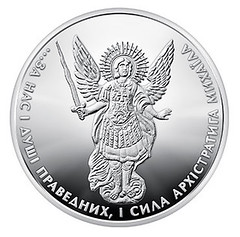 Most collectors outside Europe are likely to be primarily familiar with one particular modern Ukrainian coin series, namely the Archangel Michael silver and gold bullion coins issued since 2011. The coin was designed by Volodymyr Taran, Oleksandr Kharuk and Serhii Kharuk. The engraving was done by Roman Chaikovskyi and Sviatoslav Ivanenko.
Most collectors outside Europe are likely to be primarily familiar with one particular modern Ukrainian coin series, namely the Archangel Michael silver and gold bullion coins issued since 2011. The coin was designed by Volodymyr Taran, Oleksandr Kharuk and Serhii Kharuk. The engraving was done by Roman Chaikovskyi and Sviatoslav Ivanenko.
Michael is the patron saint of Ukraine and of its capital Kyiv. In The Bible and The Quran, he was known as the captain
and leader of the heavenly hosts who protects against the Devil. He is typically portrayed as a warrior, and on the coin's reverse, he is shown holding a sword in his right hand wearing ancient attire, and sporting wings and a halo. This is surrounded by inscriptions in Ukranian that read For us and souls of righteous men, Archistratus Michael's strength.
How the war there ultimately impacts the issuance of Ukrainian collector and bullion coins, not to mention circulation issues, remains to be seen, as does how it impacts interest in and the market for Ukrainian numismatics around the world.
To read the complete article, see:
The Coin Analyst: Collecting Modern Ukrainian Coins
(https://coinweek.com/world-coins/the-coin-analyst-collecting-modern-ukrainian-coins/)
PRINCE CHARLES PERFORMS MAUNDY CEREMONY
As noted last week, Queen Elizabeth II withdrew from this year's Royal Maundy service. Prince Charles represented the Queen at the traditional coin-giving ceremony. -Editor
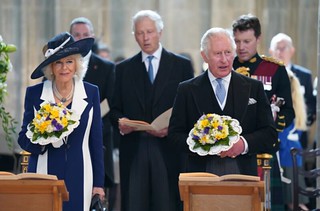 On behalf of The Queen, The Prince of Wales and Duchess of Cornwall attended the Maundy Service at St George's Chapel yesterday.
On behalf of The Queen, The Prince of Wales and Duchess of Cornwall attended the Maundy Service at St George's Chapel yesterday.
It marks the first time since 1970 that The Queen has not attended the service, after suffering recent mobility issues. In total, she has missed the Service four times, due to overseas tours and the birth of her two youngest children.
The future King and Queen Consort walked along a line of recipients saying a few words of gratitude to each as the purses were distributed.
During the ceremony, Maundy coins were given to 96 women and 96 men. An extra coin is added to the purses annually, along with another recipient, to mark every year since The Queen's birth. This was a decree dating back to the time of Henry IV.
The coins were given to those senior citizens in recognition of their service to their churches and communities. The sum is nominal – less than £6 – but the coins are specially struck and for most recipients a special memento.
The service, Maundy Thursday, commemorates Jesus washing the feet of the apostles at the Last Supper, takes place every year on the Thursday before Easter Sunday. The royal ceremony of awarding gifts on this day dates back to AD 600.
The Bishop of Worcester, Dr John Inge, noted The Queen had a list of Maundy money recipients and details about them. She's close by and would want me to extend to you her greetings,
he told the congregation before the service, speaking in his role as Lord High Almoner.
It's unclear to me if the images in the article are stock photos or of actual coins distributed this week. It's hard to read the dates, but I can't make out "2022" on any of them. If anyone finds photos of the 2022 coins, please send them along. Thanks. -Editor
To read the complete article, see:
PRINCE CHARLES & CAMILLA ATTEND ROYAL MAUNDY SERVICE ON BEHALF OF THE QUEEN
(https://thecrownchronicles.co.uk/royal-news/prince-charles-camilla-attend-royal-maundy-service-on-behalf-of-the-queen/)
To read the earlier E-Sylum article, see:
QUEEN WITHDRAWS FROM THE MAUNDY SERVICE
(https://www.coinbooks.org/v25/esylum_v25n15a28.html)
THE FAERIE QUEENE COINS BY JOEL ISKOWITZ
Coin designer Joel Iskowitz is producing a new Faerie Queen coin series for the East India Company. -Editor
The East India Company Collection's new Faerie Queen coin series sees this epic medieval tale of honour, chivalry, love and virtue reimagined by one of the world's leading coin designers, Joel Iskowitz.
First published in 1590, Edmund Spenser's epic poem The Faerie Queene is a classic work of medieval English literature. At over 36,000 lines long, its six books contain one of the longest poems in the English language, believed to be an allegory of the life of Queen Elizabeth I.
Book One opens with a letter written by Spenser to Sir Walter Raleigh. Spenser explains to Raleigh how his tale has been influenced by the legends of King Arthur, and other great Classical epics such as the Illiad and The Odyssey. He describes how his story will be based around a festival, hosted by The Faerie Queene, called ‘The Feast of 12 Days'.
Across each of these 12 days Queen Gloriana, the Queene of Faerieland, will listen to appeals for help from her subjects who find themselves in trouble, and on each day she will select a worthy quest and assign it to one of her bravest knights. Each of these quests, and the knight to whom it is assigned, would be the subject of one of the 12 books that would make up Spenser's complete work.
Ultimately, Spencer was only able to complete six of his intended 12 books, joined by a seventh unfinished chapter. Each book did focus on a specific quest as planned, with each knight being a personification of a particular virtue.
UNA AND THE REDCROSSE KNIGHT
Book One tells the story of The Redcrosse Knight and the quest he is given by Queen Gloriana on behalf of the lady Una; to rescue her parents from the captivity of an evil dragon. Through the various trials and tribulations of his quest, he transitions from a young peasant boy to a brave and embattled knight called Redcrosse, an allegory for St George, the patron saint of England.
Una is a beautiful princess whose mother and father have been imprisoned by a wicked dragon. Carrying a suit of armour with a red cross painted upon it, she visits The Faerie Queene during ‘The Feast of the 12 Days' to ask for the help of a brave knight in her quest to free her parents.
On LinkedIn Joel writes:
"It is a great honor and privilege for me to work with EIC, interpreting Spencer's epic poetry for today's numismatic community and all who are interested in literature, art and history."
To read the complete discussion, see:
https://www.linkedin.com/feed/update/urn:li:activity:6915095714658164737/
For more information, or to order, see:
THE FAERIE QUEENE COIN COLLECTION
(https://www.theeastindiacompany.com/bullion/the-faerie-queene-collection-2/)
THE WHIMSICAL TOKENS OF NORTHERN KENTUCKY
I missed this one last month - in his "From the Colonel's Desk" column on Coin Update, Dennis Tucker featured an article by Col. John Riley on some unusual tokens of northern Kentucky. Here's an excerpt - see the complete article online. -Editor
When I was a kid visiting coin shops and flea markets in the 1970s, a reliable giveaway or junkbox
item was often an odd-shaped aluminum or brass trade token from northern Kentucky. From the early good-fors of the late 1800s up until the early 1960s, many businesses in the communities situated across the Ohio River from Cincinnati took an imaginative eye to their promotional pieces and dispensed a wealth of interesting coinage substitutes. Newport, Kentucky, in Campbell County, is easily accessed from Cincinnati by a suspension bridge built in 1866, designed by John A. Roebling—still in use today as is his more famous (and visually similar) Brooklyn Bridge. Newport was an Army town, home to the Newport Barracks—in the period after the American Civil War incorporating into Fort Thomas—a defense point overlooking Cincinnati. (But more on Newport later in the article.) Just to the west in neighboring Kenton County is the city of Covington, long a proud German-American settlement and even now a Germanic cultural enclave.
While these two cities make up the bulk of the issuing stores, saloons, restaurants, and gas stations, there were also nearby towns such as Erlanger, Dayton, Bellevue, Bromley, and others who joined in the fun of advertising their wares in the forms of shields, artist palettes, horse heads, police badges, whiskey barrels, fish, and many other forms—even boxing gloves! It is a unique regional specialty to collect, and the tokens are instantly recognizable, even from a distance, as being from the area. A marked advantage for the vendors who ordered these tokens was the proximity to the manufacturing dynamo of Cincinnati: Greg G. Wright & Sons, James Murdock, and the Osborne Register Co. all contributed to the mix of interesting token designs and shapes, but perhaps the most creative of all came locally from the National Band and Tag Company of Newport. Still very much active at 119 years young, the company produces in addition to promotional pieces such necessities as poultry leg bands; tags for livestock, cats. and dogs; and all manner of industrial and commercial tags. As Prohibition lifted in 1933 and the Great Depression waned, National Band and Tag was uniquely situated to provide a cheerful diversion to generations of their customers and neighbors.
To read the complete article, see:
From the Colonel's Desk: The whimsical tokens of northern Kentucky—and the story of Sin City
(http://news.coinupdate.com/from-the-colonels-desk-the-whimsical-tokens-of-northern-kentucky-and-the-story-of-sin-city/)
LARGE BRONZE SEPTEMBER 11TH MEDALS
In my college days I worked as a programmer for a cancer research project at the University of Pittsburgh. I've long forgotten what was in it, but one day I was carrying a box and asked coworkers to "guess what's in it?" Knowing about my hobby, one woman asked, "A really big coin?"
Bless her heart. It wasn't a yap stone, but I was reminded of that long-ago conversation after seeing this Greysheet article by James Bucki on the large-size bronze versions of the September 11th Congressional Gold Medals. Here's an excerpt - see the complete article online. Bigger is better, even when it comes to medals. -Editor
My coin collecting journey of fifty years has taken me to various destinations. Like many collectors, I started out collecting Lincoln cents as an ambitious ten-year-old. Fast forward about twenty years, and my disposable income increased dramatically. I collected proof sets, Jefferson Nickels, Roosevelt dimes, type sets, world coins, and many more.
Recently I ventured into the world of exonumia. I acquired all three of the three-inch Fallen Heroes of September 11th Bronze Medals. Their size and weight are impressive. But what is more impressive is the extreme detail that is visible to the naked eye. The medal's true artistic beauty and symbolism of this tragic event shines through in these large-format medals.
The tragic events at the World Trade Center in New York City, Pentagon in Washington, DC, and in rural Pennsylvania on September 11th, 2001, had a permanent impact on the United States. Ordinary civilians, law enforcement officers, emergency responders, military members, and government employees took heroic and honorable action on that day.
Public Law 112-76 authorizes the production of three Congressional Gold Medals – one for each of the three sites. The three-inch bronze medals are exact duplicates of the U.S. Mint's Congressional Gold Medals. The one-and-a-half-inch medals are replicas using a smaller die.
To read the complete article, see:
Bigger Is More Beautiful
(https://www.greysheet.com/news/story/bigger-is-more-beautiful)
2022 AMERICAN MEDAL OF THE YEAR AWARDS
Mel Wacks forwarded this announcement from the American Medallic Sculptors Association. Thanks. -Editor
Save Our Planet from Covid-19Medal by Keiko Kubota-Miura Wins
the 2022 American Medal of the Year (AMY) Award
The American Medallic Sculptors Association (AMSA) has announced that Keiko Kubota-Miura has won the 2022 American Medal of the Year (AMY) award for her innovative work titled Save Our Planet from Covid-19.
Keiko describes her work as a self-portrait medal when NY was in the Covid-19 epidemic, and I am the plant growing strong with others in the midst of it. Our lives must also change to protect this planet of ours. And live in symbiosis with all things, solid and alive, not defeated by Covid-19 - Save Our Planet.
Save Our Planet
is 6 x 6 x 3; Keiko delineates its production as follows: The medal is made from a sheet of copper, made into a round shape with a hammer and chisel. The plants inside and the club-shaped spikes of Covid-19 are made from copper rods. The shapes are assembled by soldering and electric welding. The natural oxidized color of the copper is created during the production process, after which each piece is patinated in hues of dark brown and greenish-blue, and finally 24K gold leaf is applied.
While similar medals by Keiko sell for thousands of dollars, she has agreed to make up to 10 duplicates of Save Our Planet,
priced at just $999 each plus $25 shipping. Orders and information can be obtained by contacting Ms. Kubota–Miura at
keikokmny@gmail.com or (347) 513-0138. Note that since each medal must be hand assembled, each medal will be slightly different and unique.
The two other finalists are civil rights leader John Lewis
by Jim Licaretz, 3 ½ inches cast in bonded bronze and priced at $75.00 plus $7 shipping, and Pandemic Selfie,
4 x 2 inches cast in hydro-stone and hand-painted, by Eva Wohn, priced at $65 plus $7 shipping. To order, contact Licaretz at
idolls@earthlink.net or (310) 686-0920, or Wohn at
ewohn@hotmail.com or
(202) 341-3301.
All 39 AMY entries will be pictured in the next full color issue of AMSA's Members Exchange. Art medal collectors and designers are invited to learn about and join the American Medallic Sculpture Association at www.amsamedals.org.
SIAM 5 TICALS WITH FRENCH INDO-CHINA BACK
World Banknote Auctions President Dennis Hengeveld catalogued an interesting Thailand note for their upcoming sale 25. Here's the full entry. -Editor
Thailand / Siam, Banque de l'Indochine 1888 (ND 1898) P-S101p PMG Gem UNC 65 EPQ 5 Ticals (Proof with French Indo-China Back)
Iconic and extremely rare proof or trial for Siam, printed with a back plate meant for French Indo-China
In the late 19th and early 20th centuries various European Colonial powers attempted to gain access to the economy in various regions in Asia, including Thailand, then known as Siam. The number of foreign banks that were allowed to issue banknotes in Siam was extremely small, and any survivors are extremely rare and in demand today. The first foreign bank to issue banknotes in Siam was the Hong Kong and Shanghai Banking Corporation, which issued notes denominated in Ticals in the late 1880s from their office in Bangkok. In the next two decades these were supplemented by issues from the Chartered Bank of India, Australia & China and the Banque de l'Indo-Chine. This is a proof for the 5 Ticals (or Ticaux in French) of the latter bank and is part of an extremely limited group of notes from this branch that have survived to the present day. What makes the piece offered here particularly interesting is that while the front is clearly printed for Siam, the back is that of a French Indo-China issue, with vertical text in Chinese, compared to the issued note that has Thai and Chinese text in black.
Origins of this Piece
We have attempted to piece together the history of this piece to the best of our knowledge. According to a previous auction listing that included this trial it appears to have been originally part of a 5-piece set of Banque de l'Indochine specimens & trials from the Bangkok branch that in the early 1990s was purchased by a coin dealer from an undisclosed museum in Paris for $90,000. The existence of this type was made public in an article in the April 1999 issue of the Banknote Reporter in a brief article titled "Odd Siam Five-Tical note has different back text", noting that photos of that note were submitted by noted Thai numismatist Lee Shin Song of Bangkok. This is a different piece than the one in this auction, as the annotation is in a different position (we believe that the annotation of this second piece has since been removed, but it is identifiable by a patch of toning on the back). The note in this auction was then offered by R.M. Smythe in the Spring of 2008 as part of a 5-piece set with an estimate of $100,000-$125,000. The set failed to sell but was later sold privately. This note was then put into auction recently where our consignor acquired it, realizing the significance of this piece (in that sale this piece was listed as an ordinary proof). The existence of another piece indicates that it was not an error, but perhaps a trial piece deliberately produced before the back plate was finished.
Rarity of Siam Branch Banque de l'Indo-Chine banknotes
This particular example is the only such proof certified by PMG (the PMG population report lists just additional specimen, but it is in circulated grade) and we know that the first note issued (serial number 1 from the first block) was saved, but that piece is in the Bank of Thailand Museum Collection and possibly unique as an issued note. None of the higher denominations (the Pick catalog lists a 20 Ticals, 80 Ticals and 100 Ticals) have been offered in recent memory either in any format, and none appear in the PMG population report. From our research it appears that there are about a dozen pieces from the Bangkok branch of the Banque de l'Indo-Chine in existence across all denominations, including pieces in museum collections.
The Bangkok branch of the Banque de l'Indo-Chine opened on February 22, 1897 and was the first branch of the bank to operate outside of the French Colonies. The Banque de l'Indo-Chine had been founded in 1875 and initially concentrated its operations in French Indo-China (present-day Viet Nam), although it would later expand to other French Colonies, including French India, New Caledonia, Tahiti and French Africa. Note-issuing privileges were extended to all of these regions and notes issued by the bank are often seen today. However, notes from both the Thailand and China branches of the bank are seldom seen today in any format. Most Banque de l'Indo-Chine notes were printed in Paris at a central location, so it is possible that (whether purposefully or note) plates for different colonies were mixed.
This proof or trial piece (in coin terms it would perhaps be identified as a pattern, but that term is typically not used to identify trial banknotes) its present state of preservation is exceptional. Official annotations are noted, but these help identifying this piece, as the note lacks serial numbers or a date. A fascinating and extremely rare piece that is worthy of inclusion in any serious French colonial paper money collection.
Pick-S101s var. (for Siam). Listed in French Southeast Asia Coins & Currency by Howard A. Daniel III (page 212). Not listed in Kolsky. PMG mentions "Printer's Annotations".
To read the complete lot description, see:
Thailand / Siam, Banque de l'Indochine 1888 (ND 1898) P-S101p PMG Gem UNC 65 EPQ 5 Ticals (Proof with French Indo-China Back)
(https://bid.worldbanknoteauctions.com/lots/view/4-5PE4BA/thailand-siam-banque-de-lindochine-1888-nd-1898-p-s101p-pmg-gem-unc-65-epq-5-ticals-proof-with-french-indo-china-back)
WHO'S IN YOUR WALLET?
"Who's in Your Wallet?" is a great new interactive visual essay about the famous figures represented on today's currencies around the world. They looked at a number of aspects of each figure including occupation as well as gender and whehter the figure was know as the first to do or be something. Interestingly, there are slightly more writers at the head of the list then heads of government. President who? -Editor
If you open your wallet right now, who do you see there? You're probably looking at people who made history in your country. Without even noticing, you're always carrying around reminders of prominent people in your wallet, but have you ever wondered, who gets to be on banknotes?
In many places, paper money still fails to represent a portion of the population it serves, with many countries preferring to showcase people (usually men) in positions of power or of national acclaim on their banknotes. However, money can also be a platform to uplift the unsung leaders who deserve our gratitude for making our countries what they are. We decided to investigate this imbalance. We gathered data about the people who appear on banknotes around the world, to see what we could learn about them and their countries.
We wanted this analysis to be as international as possible so we inquired into 38 countries from all 22 sub and sub-subregions of the world, based on the United Nations' Statistics Department geoscheme.
19% of people featured on banknotes are Writers (45 people from 23 countries).
Writing was the most common profession among women and the second most common for men.
Some notable figures in this category include Colombia's first Nobel Prize of Literature winner Gabriel García Márquez, the pioneer of Japanese modern literature Ichiyo Higuchi and Turkish writer Fatma Aliye Topuz, who is known as the first female author in the Islamic world.
Writers can give voice to a place, time, and culture in a way that can resonate and instill a sense of shared identity among citizens, perhaps making them such a popular choice to feature on banknotes.
While writers seem like a safe choice to be on banknotes, they can also cause controversy. For instance, Israel exclusively features Hebrew poets whose life stories, works, and activities are intertwined with the story of the rebirth of the Nation of Israel in its land,
according to the Bank of Israel website.
Yet, many decry that the current Israeli series only represent Ashkenazi Jews and don't include anyone of Sephardi or Mizrahi heritage, an exclusion that some hope will be solved in following editions.
The second most common profession in the dataset is Head of Government, which only features one woman: Corazon C. Aquino.
She was president of the Philippines from 1986 to 1992 and is known for restoring democracy after the dictatorship of Ferdinand Marcos.
We classified monarchs as separate from heads of government because oftentimes they don't play that role.
There are just 12 monarchs featured on banknotes and only two of them are women: Queen Elizabeth II and Queen Tamar of Georgia.
On average, 29% of people in a country's currency were known for being the first ones to do something, whether it was being the first of their demographic to be a member of Congress, the first president of a nation, or the first Indigenous person to graduate from a national university. These are just some of the firsts
that are featured on banknotes in this dataset.
More interactive visual articles like this would be a great way to educate the public and promote numismatics. Take notice, organizations and publishers! -Editor
To read the complete article, see:
Who's in Your Wallet?
(https://pudding.cool/2022/04/banknotes/)
THE DEFEND AMERICA COIN SAVINGS BOOK
I came across this interesting book in a Reddit post. Have any of our readers seen one of these before? Who made them? When? -Editor
To read the complete Reddit post, see:
https://www.reddit.com/r/coins/comments/u0rxk6/
girlfriend_found_this_in_a_box_of_junk_for_me/
LOOSE CHANGE: APRIL 17, 2022
Here are some additional items in the media this week that may be of interest. -Editor
A short Coin World article by Steve Roach discusses the strong market for vintage slabs. -Editor
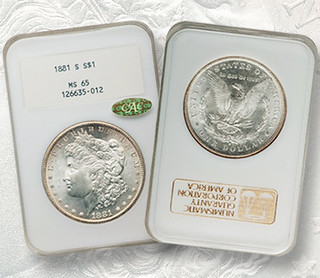 Vintage slabs from the early days of third-party coin grading continue to be hot sellers at auction, as seen in several auctions at GreatCollections and an online auction at Heritage that focused on vintage and unusual slabs.
Vintage slabs from the early days of third-party coin grading continue to be hot sellers at auction, as seen in several auctions at GreatCollections and an online auction at Heritage that focused on vintage and unusual slabs.
Heritage sold an 1881-S Morgan silver dollar — the most common date in the series in nicer Mint State grades — graded Mint State 65 by Numismatic Guaranty Co. for a hefty $5,040 on March 7.
Sans the early slab, the 1881-S typically sells for $200 or so. -Editor
To read the complete article, see:
Market Analysis: Strong market for vintage slabs
(https://www.coinworld.com/news/us-coins/market-analysis-strong-market-for-vintage-slabs)
The Bank of England museum has a new exhibit on its connections with transatlantic slavery. -Editor
This exhibition explores the history of transatlantic slavery through its connections with the Bank of England and the wider City of London.
For over 300 years, the slave trade tore more than 12 million African people from their homes and families. In this exhibition, we reflect on how the wealth created through transatlantic slavery shaped the development of Britain.
Open now: The exhibition will be open Monday to Friday 10am – 5pm, with late openings until 8pm every third Thursday of the month.
Entry is free, and no need to book ahead.
To read the complete article, see:
Slavery & the Bank
(https://www.bankofengland.co.uk/museum/whats-on/slavery-and-the-bank)
A Coin Update article by Dave Bowers discusses the once-rare 1903-O silver dollar. -Editor
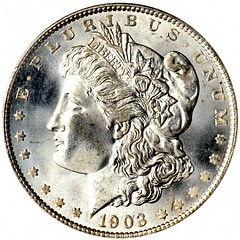 In 1903 at the New Orleans Mint, 4,450,000 million circulation strike silver dollars were minted. Not needed in circulation at the time, most of the coins were placed in storage. Silver dollars were a glut in American commerce, and even the Treasury Department did not know what to do with all of them. The Bland-Allison Act of February 28, 1878, the Sherman Silver Purchase Act of 1890, and other boondoggle pieces of legislation were enacted to make Uncle Sam the buyer for millions of ounces of silver mined in the West.
In 1903 at the New Orleans Mint, 4,450,000 million circulation strike silver dollars were minted. Not needed in circulation at the time, most of the coins were placed in storage. Silver dollars were a glut in American commerce, and even the Treasury Department did not know what to do with all of them. The Bland-Allison Act of February 28, 1878, the Sherman Silver Purchase Act of 1890, and other boondoggle pieces of legislation were enacted to make Uncle Sam the buyer for millions of ounces of silver mined in the West.
It was determined that the easiest way to store all of this silver was to mint it into the largest denomination of that metal, the silver dollar. From March 1878 onward, hundreds of millions of silver dollars were struck, using a design by George T. Morgan (hence the Morgan dollar
). Millions were placed into circulation, but hundreds of millions of others were stored in vaults set up by the Treasury, including at other mints, at the Treasury Building next to the White House in Washington, and in government Post Office buildings. By 1918 about a half-billion unwanted silver dollars were in storage.
To read the complete article, see:
Bowers on Collecting: The fascinating 1903-O silver dollar
(http://news.coinupdate.com/bowers-on-collecting-the-fascinating-1903-o-silver-dollar-2/)
SCULPTURE MADE FROM 1 MILLION EURO CENTS
Now that's a lotta coin! A sculpture was created from 1 million Euro cents. -Editor
A sculpture made of one million European one-cent coins worth 100,000 Euros and weighing up to four tons has been set up in the heart of the Austrian capital Vienna.
Artist Julia Bugram glued the coins together as a pair of hands holding on to each other as a way of raising awareness of the need for solidarity.
The hefty work of art has been installed next to St. Stephen's Cathedral (Stephansdom) in the center of Vienna and it will remain there until at least June.
Newsflash obtained a statement from the organization behind the sculpture, Raising Hands, and they said that the coins alone weigh 2.3 tons.
After adding the weight of the glue and the pedestal, the whole structure is believed to weigh between three and four tons.
Raising Hands explained: "However, the focus of the project is not on the money, but on working together and strengthening the community, overcoming hurdles together and making this solidarity visible through art."
Raising Hands, who say they stand for "cohesion in society" added: "Participation and the idea of solidarity are the focus. Raising Hands works on the principle of inclusion — everyone is invited to come together to form a community. Raising Hands makes the impossible possible.
"Processing 2.3 tonnes of coins is almost impossible for one person alone. Through cohesion in the community, the best results are often achieved and also the initially impossible. Every contribution counts. No matter in what form."
Found via News & Notes from the Society of Paper Money Collectors (Volume VII, Number 43, April 12, 2022) -Editor
To read the complete article, see:
Sculpture Made from 1 Million Euro 1-cent Coins goes on Display
(https://www.newsweek.com/sculpture-made-1-million-euro-1-cent-coins-goes-display-1695633)

